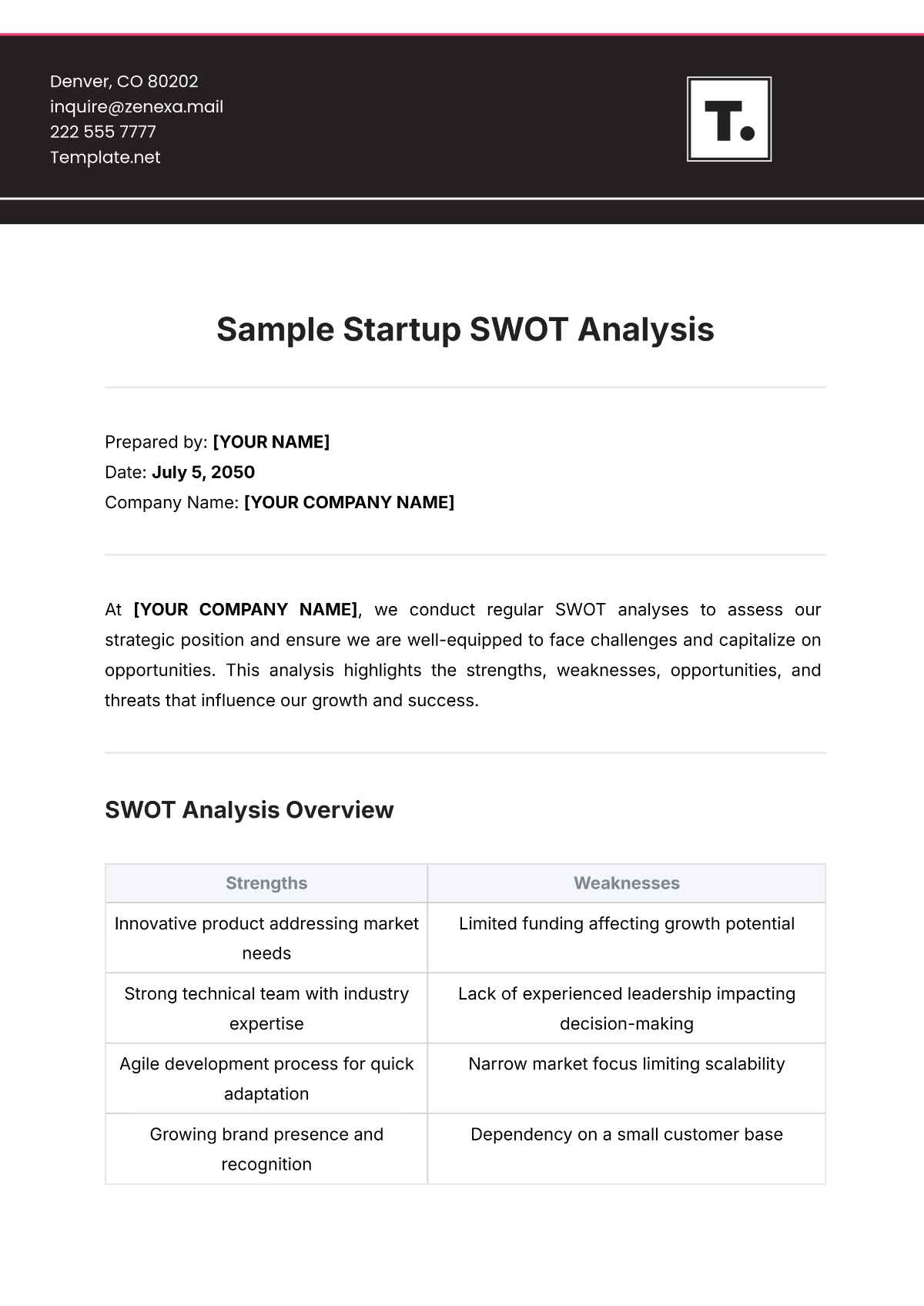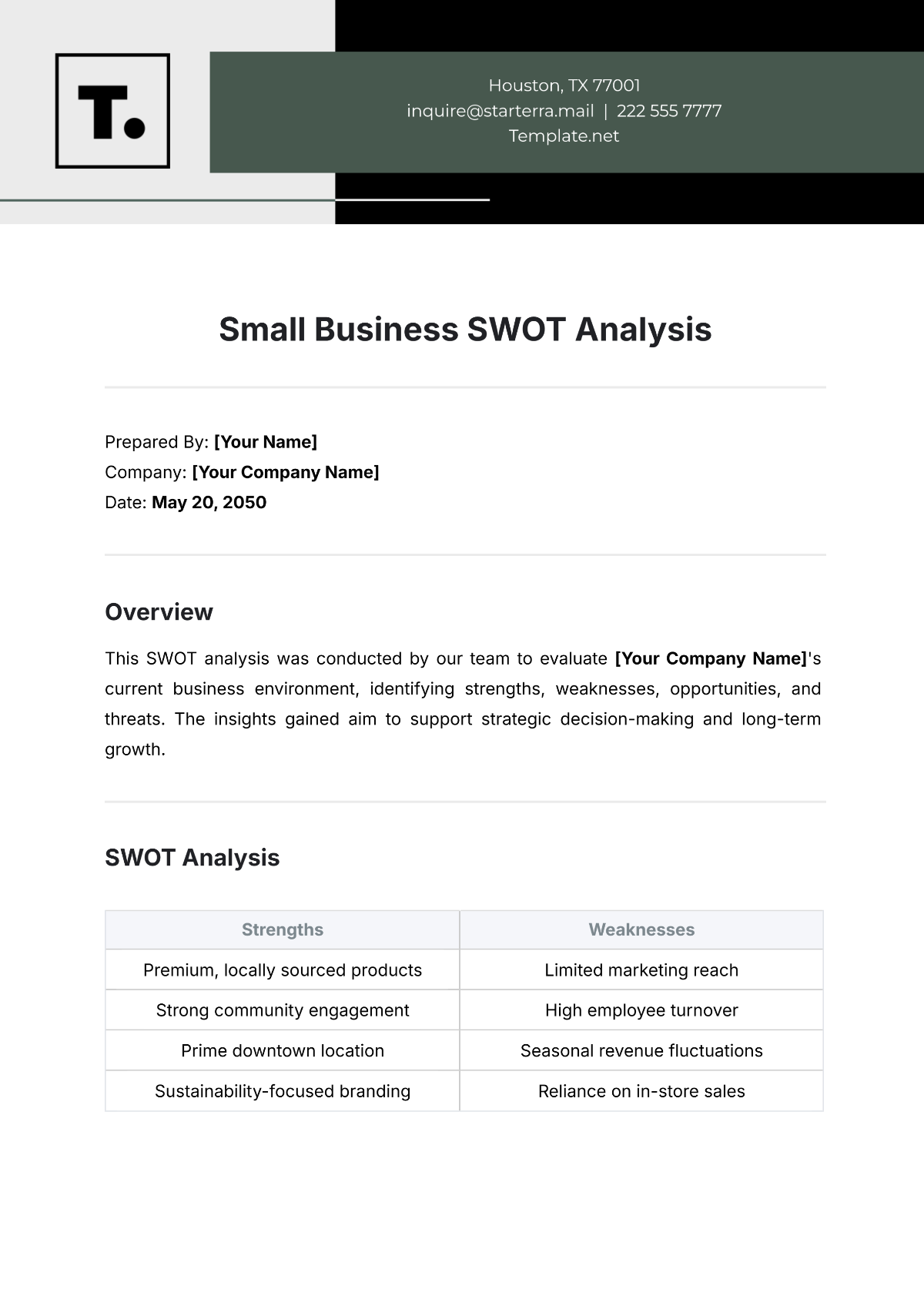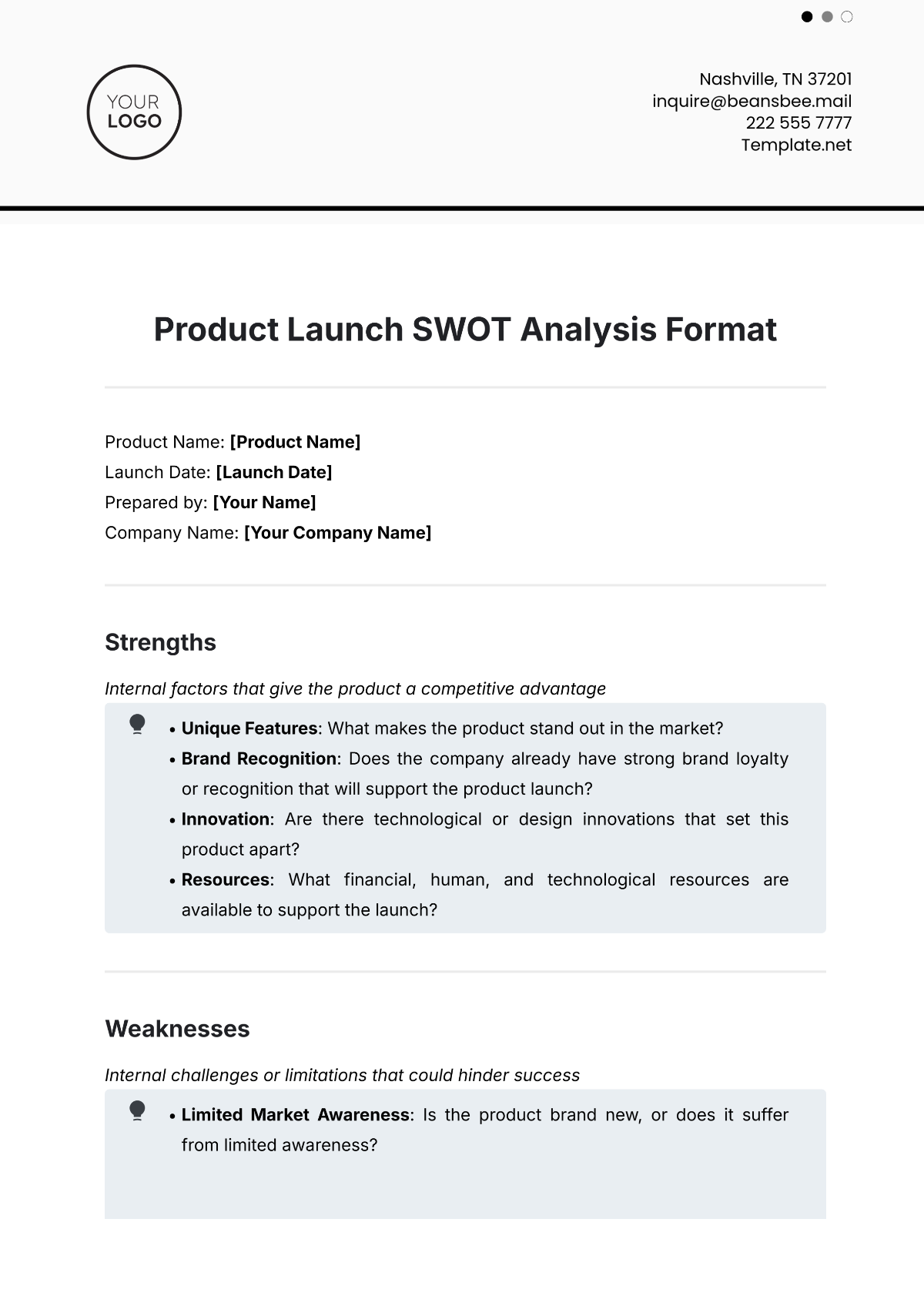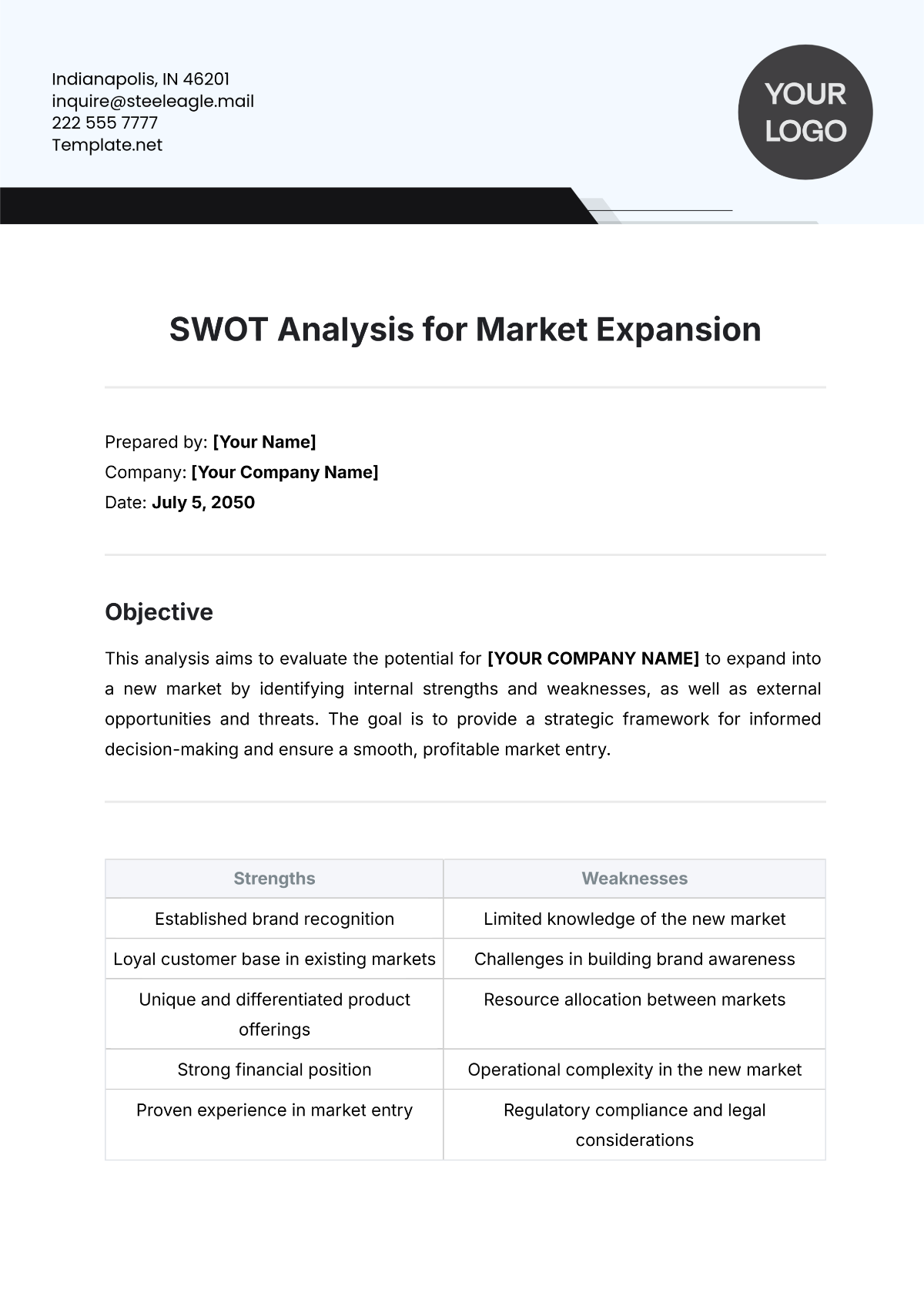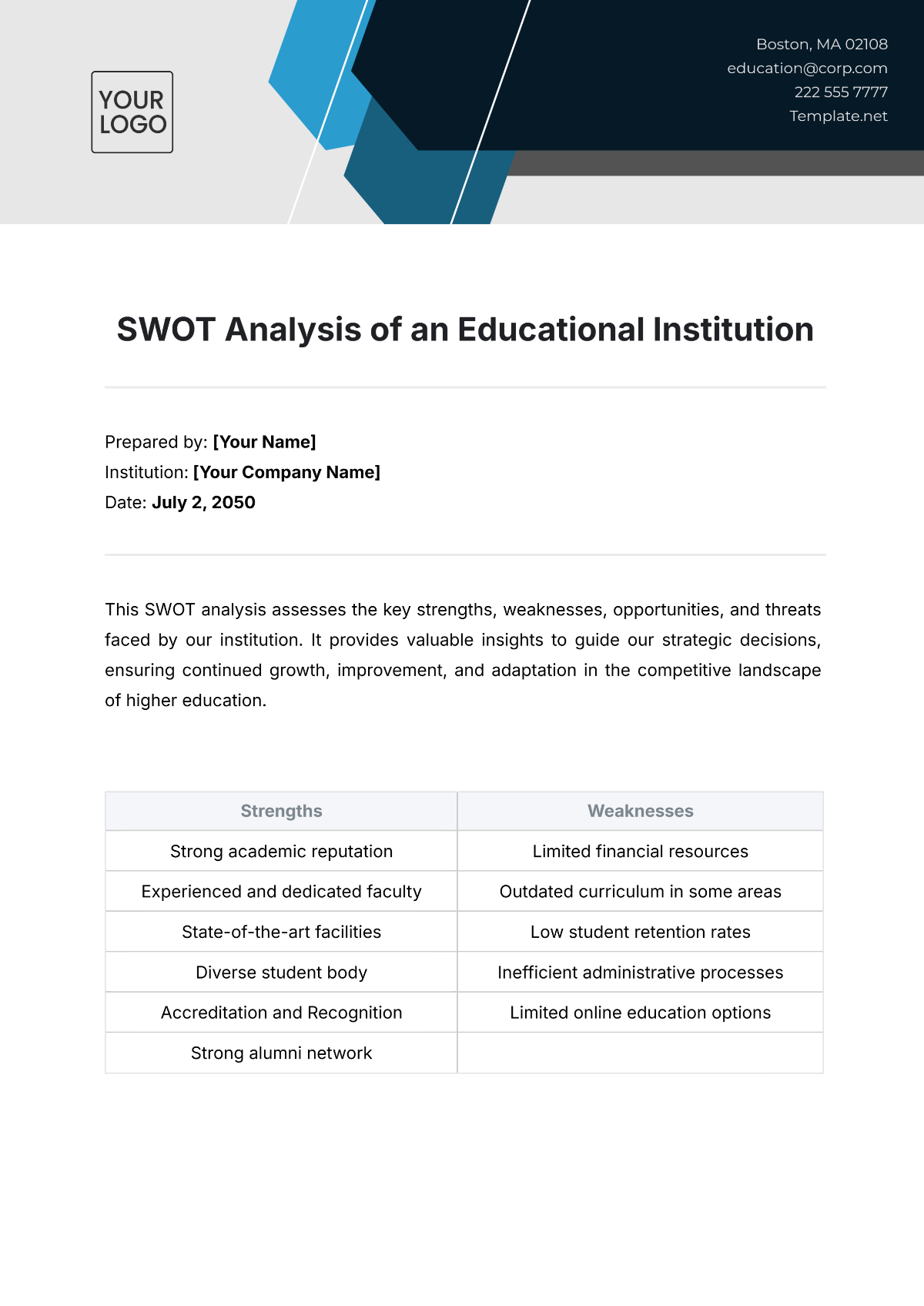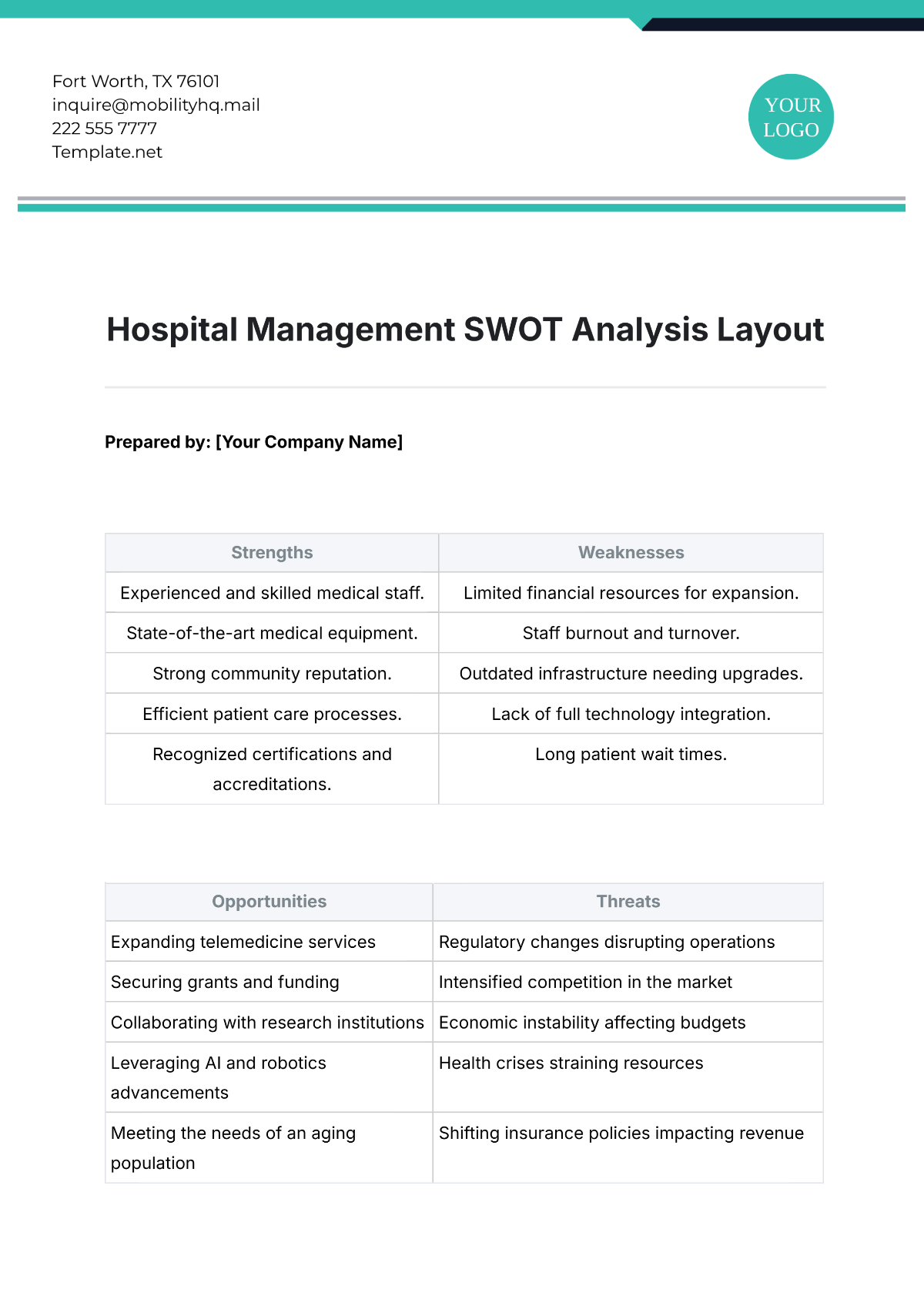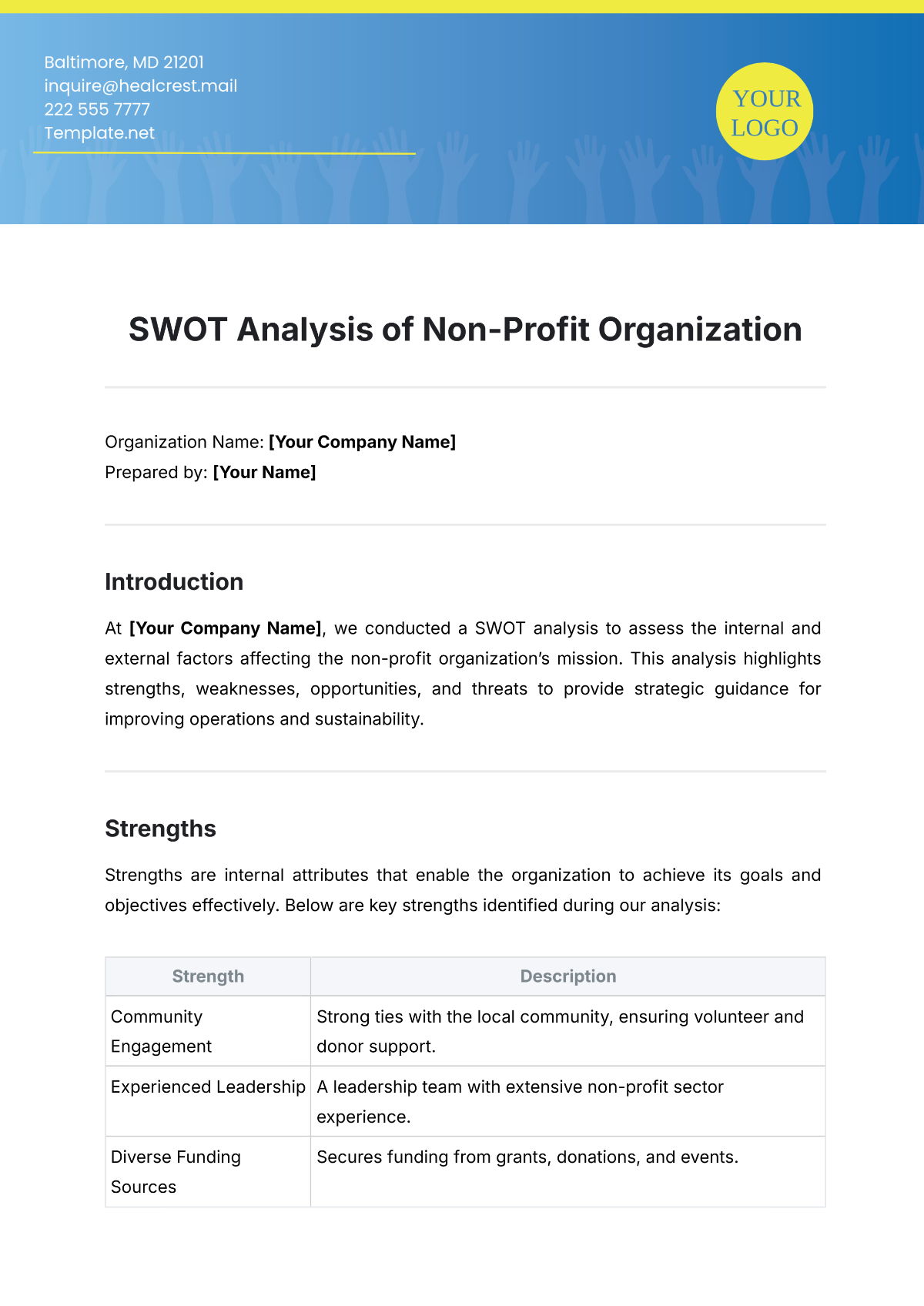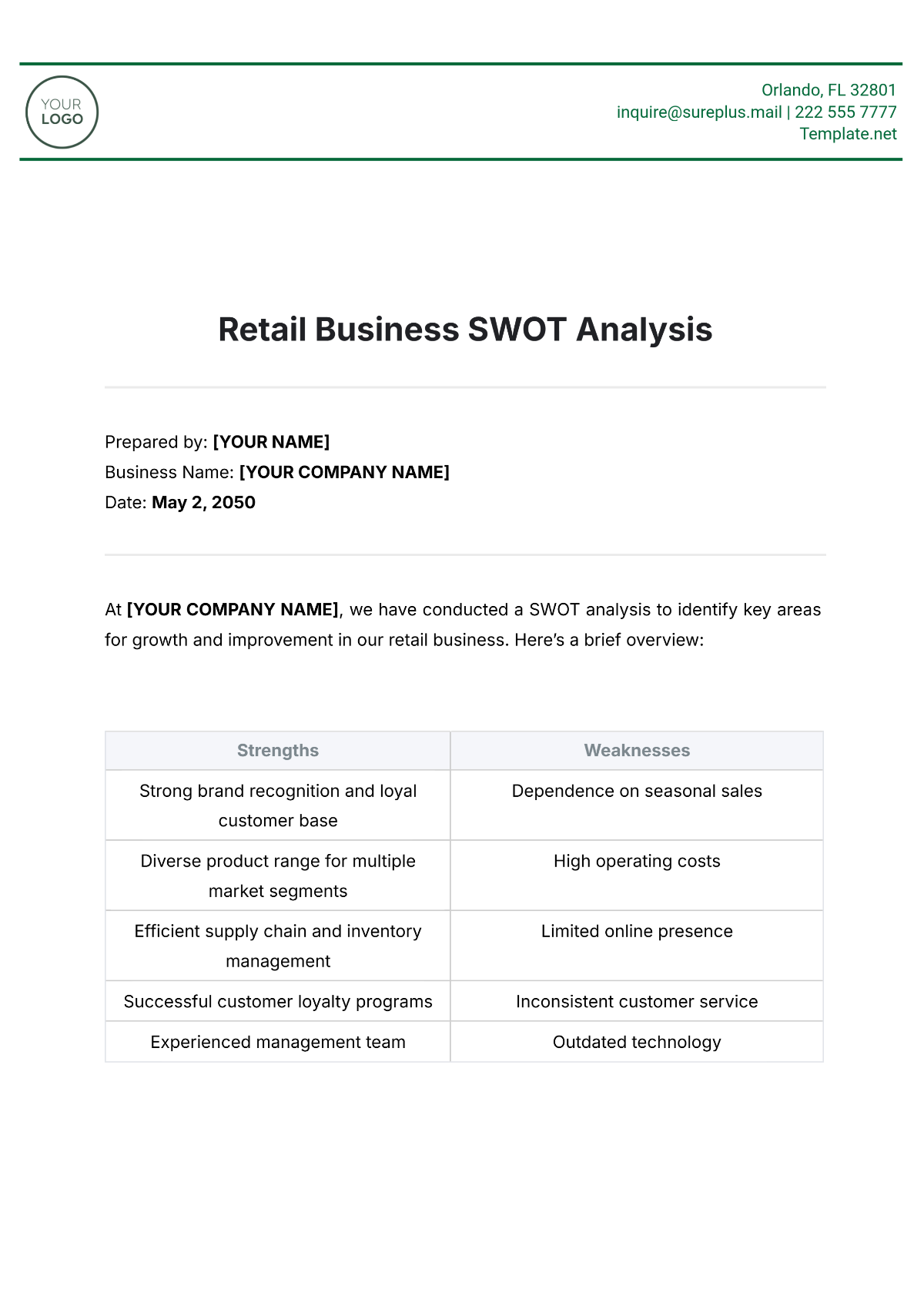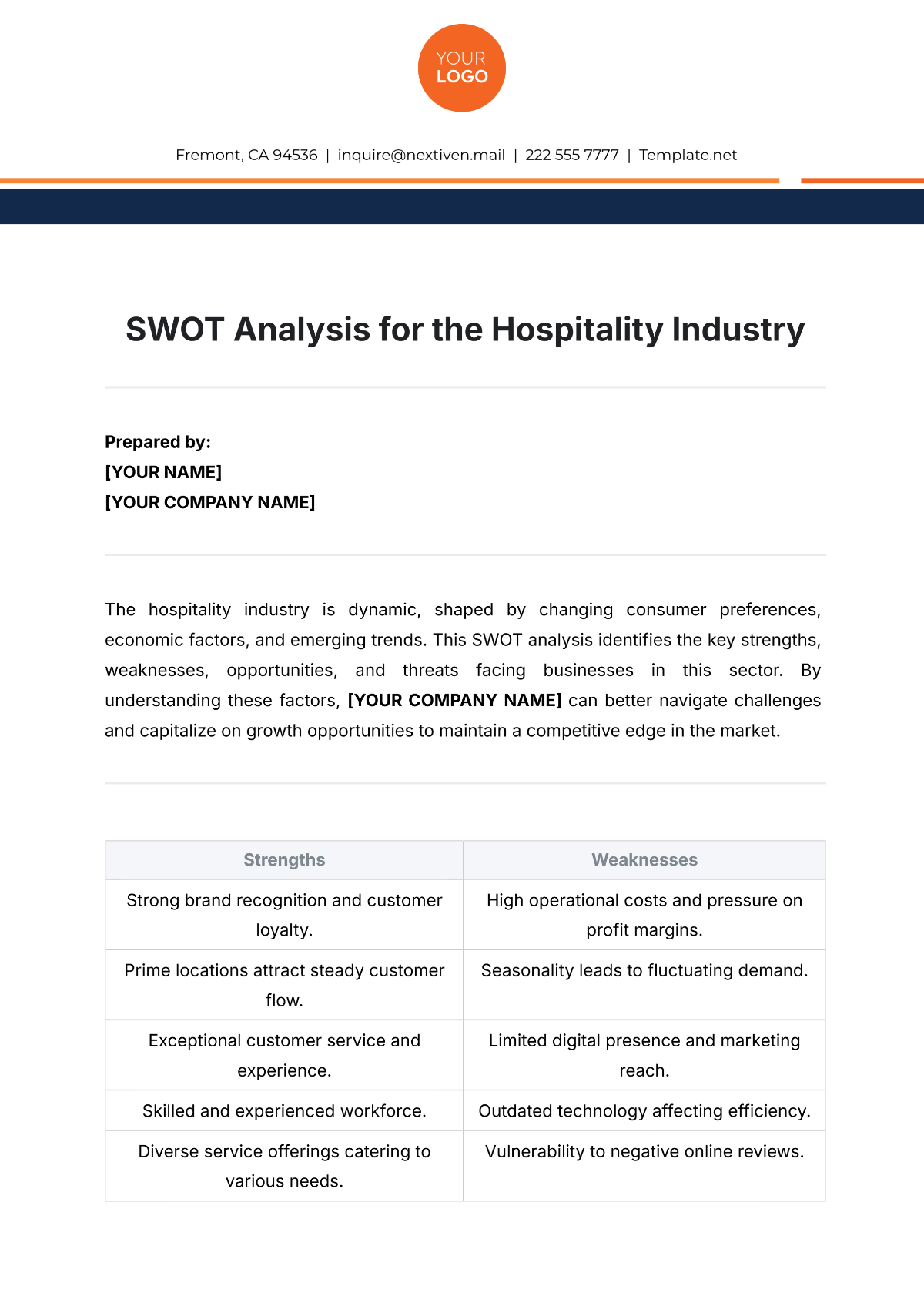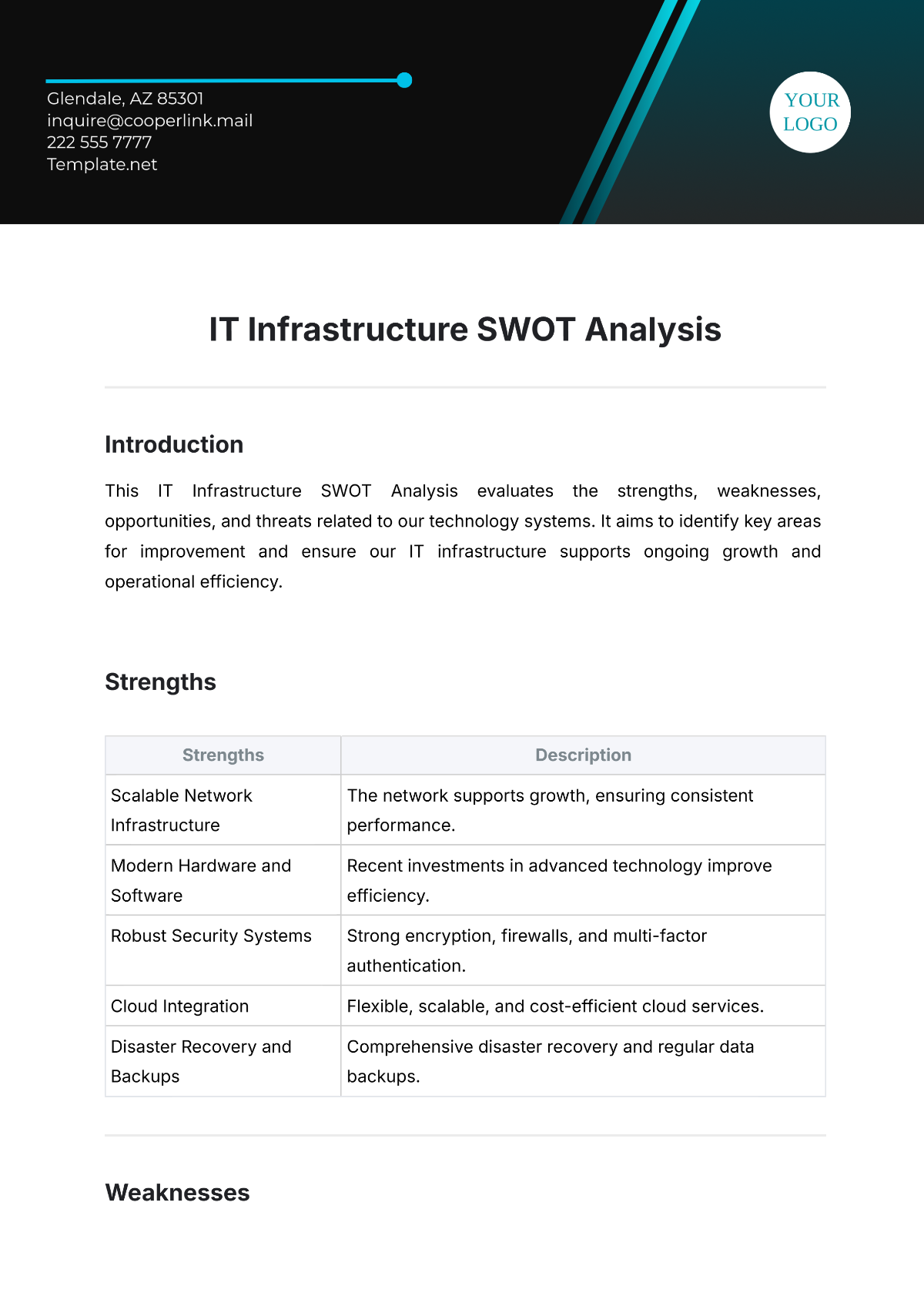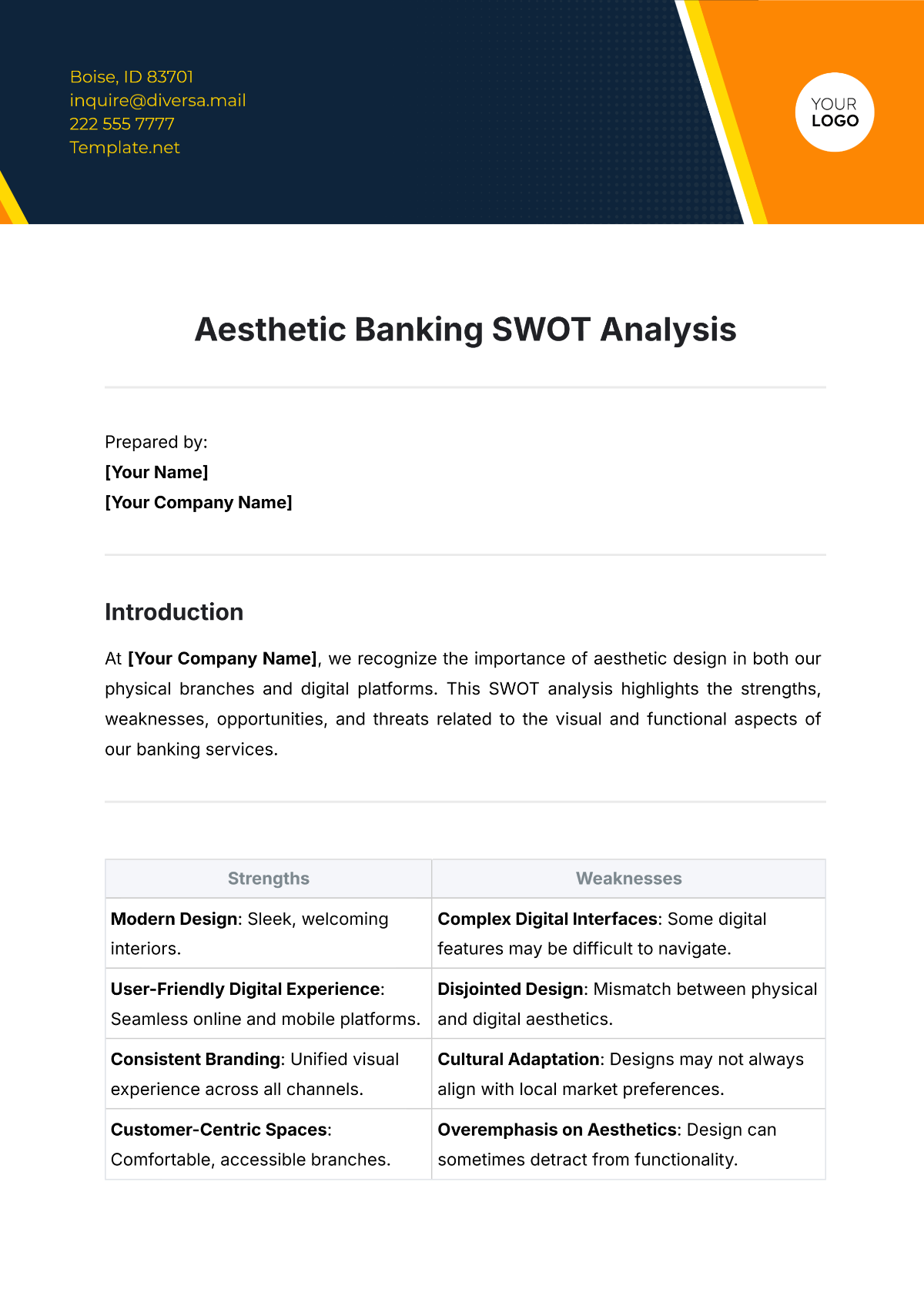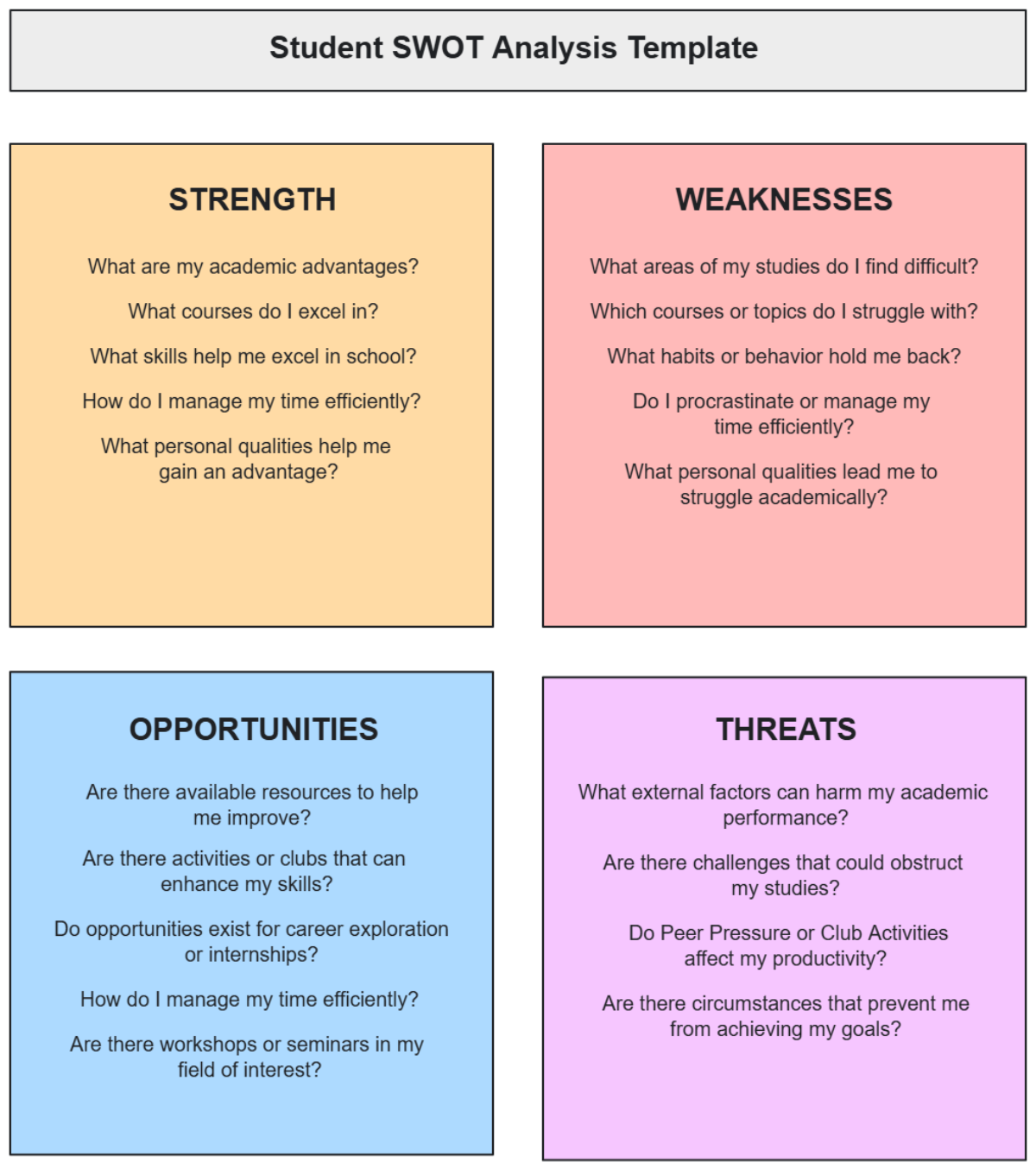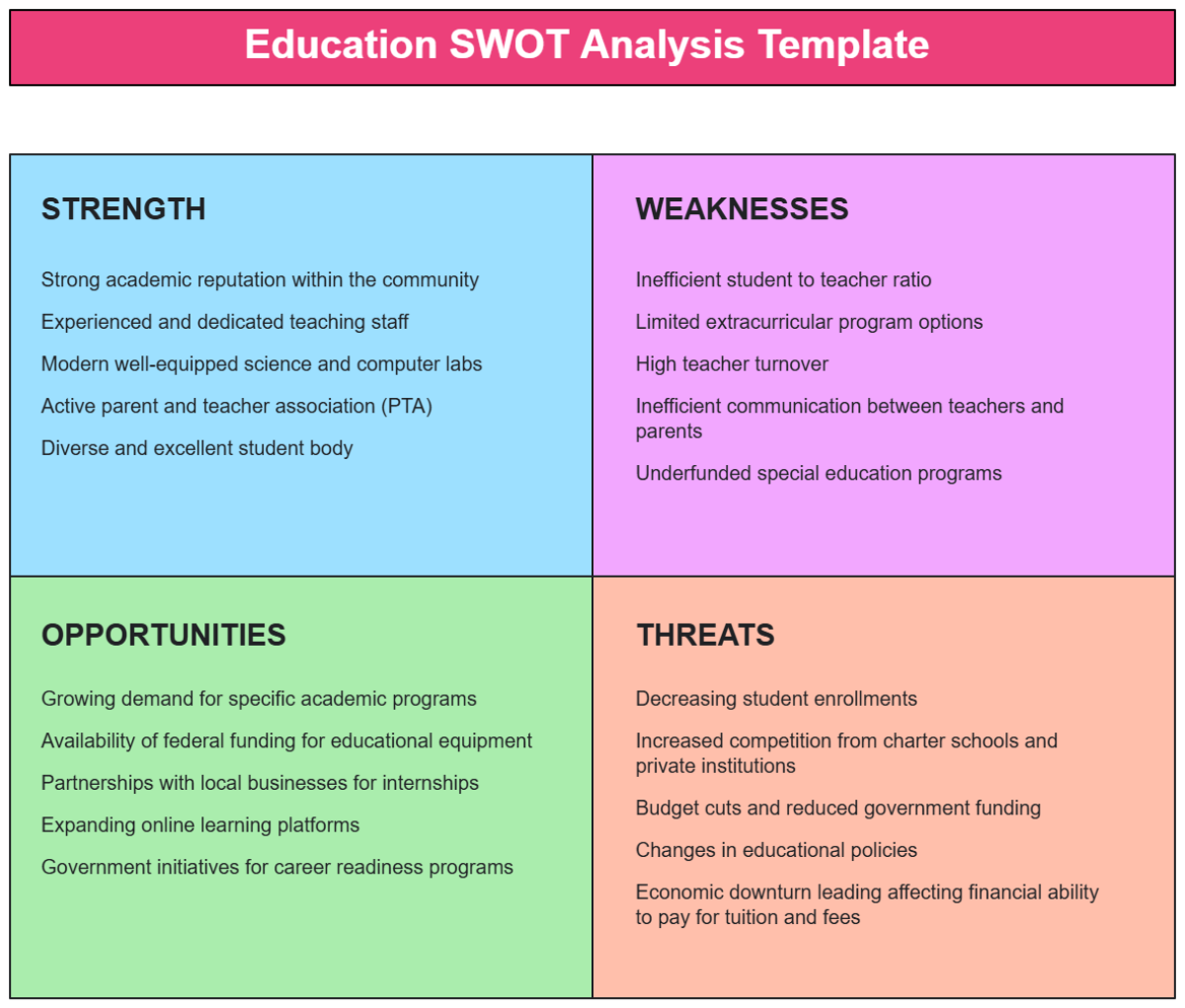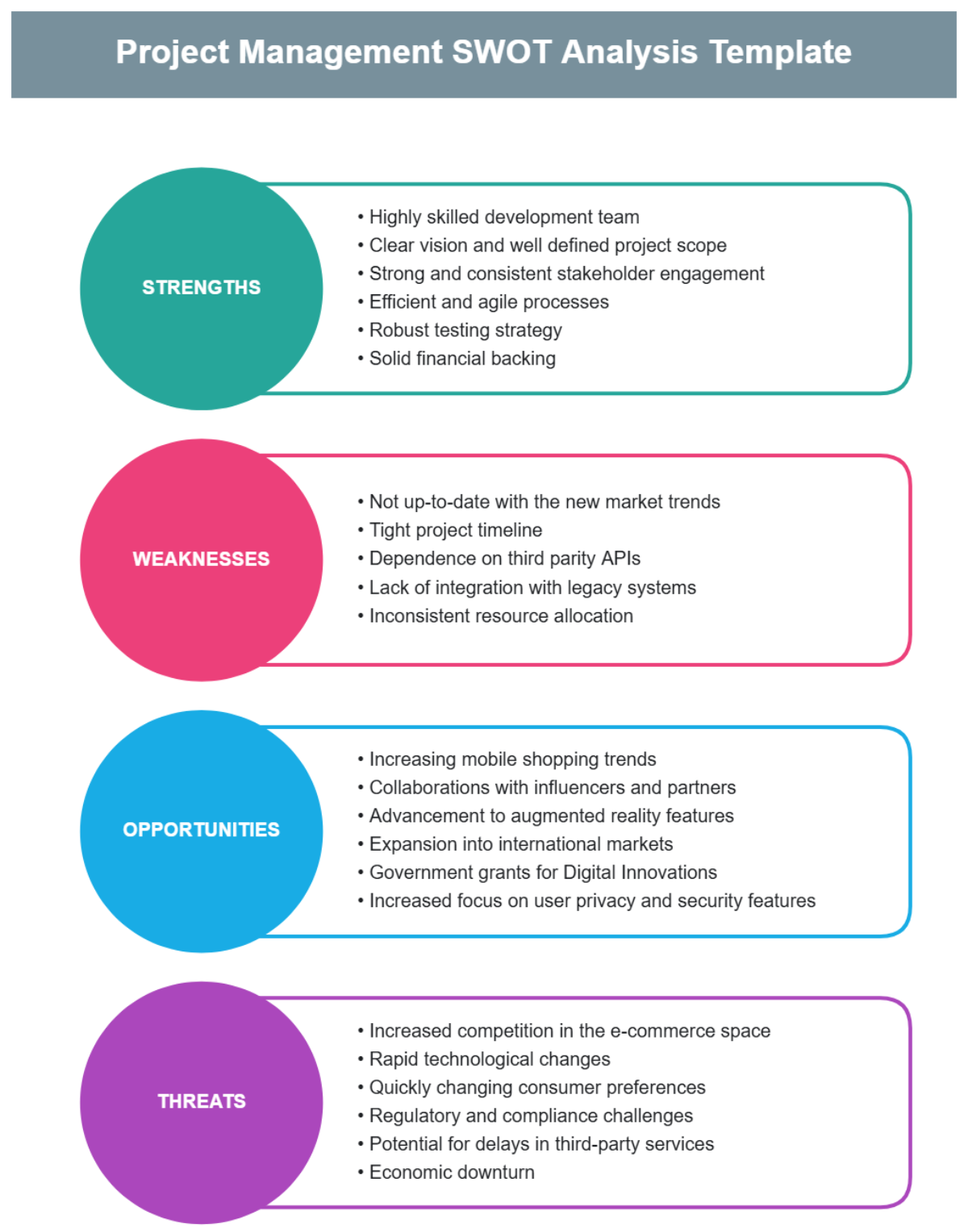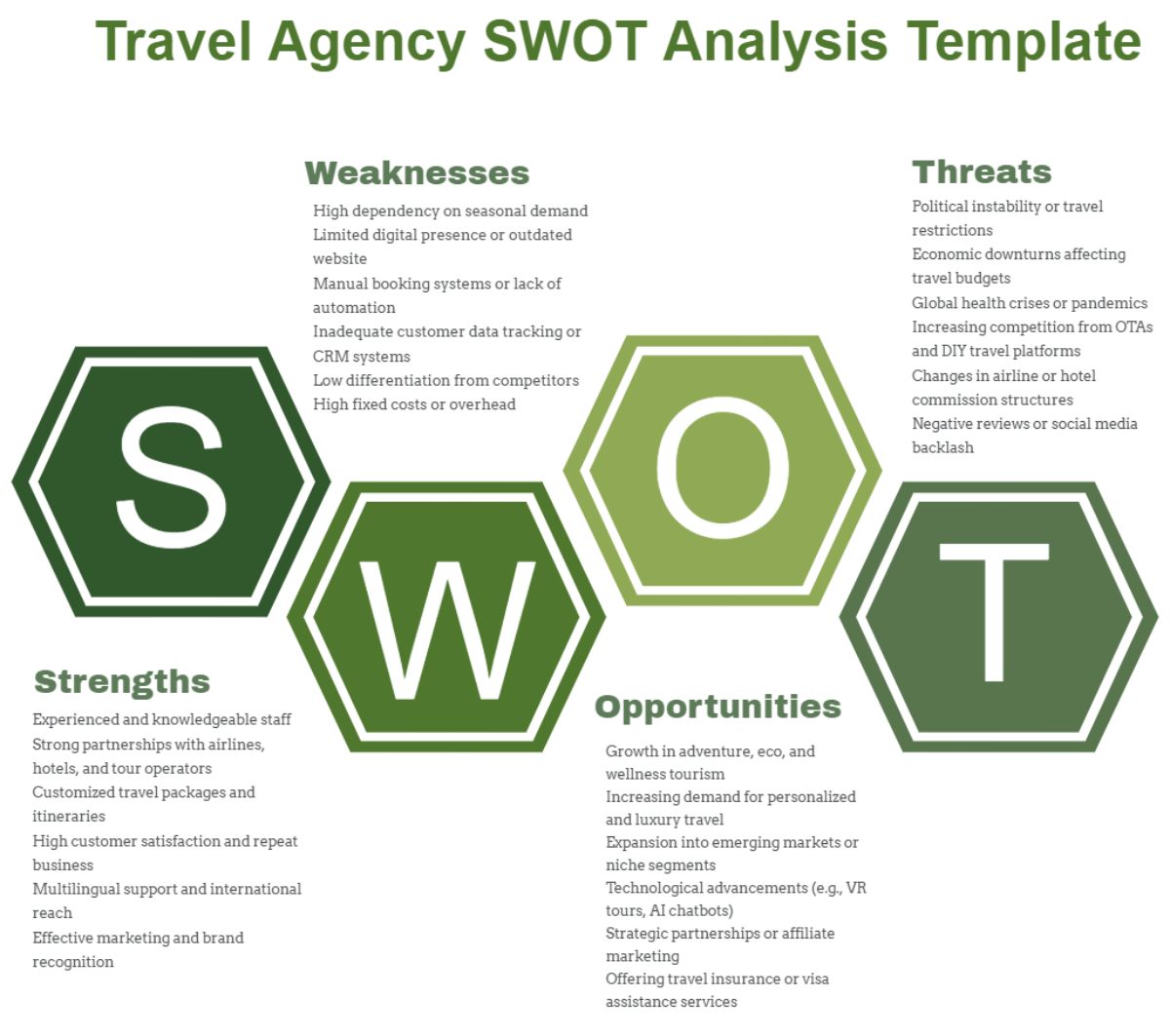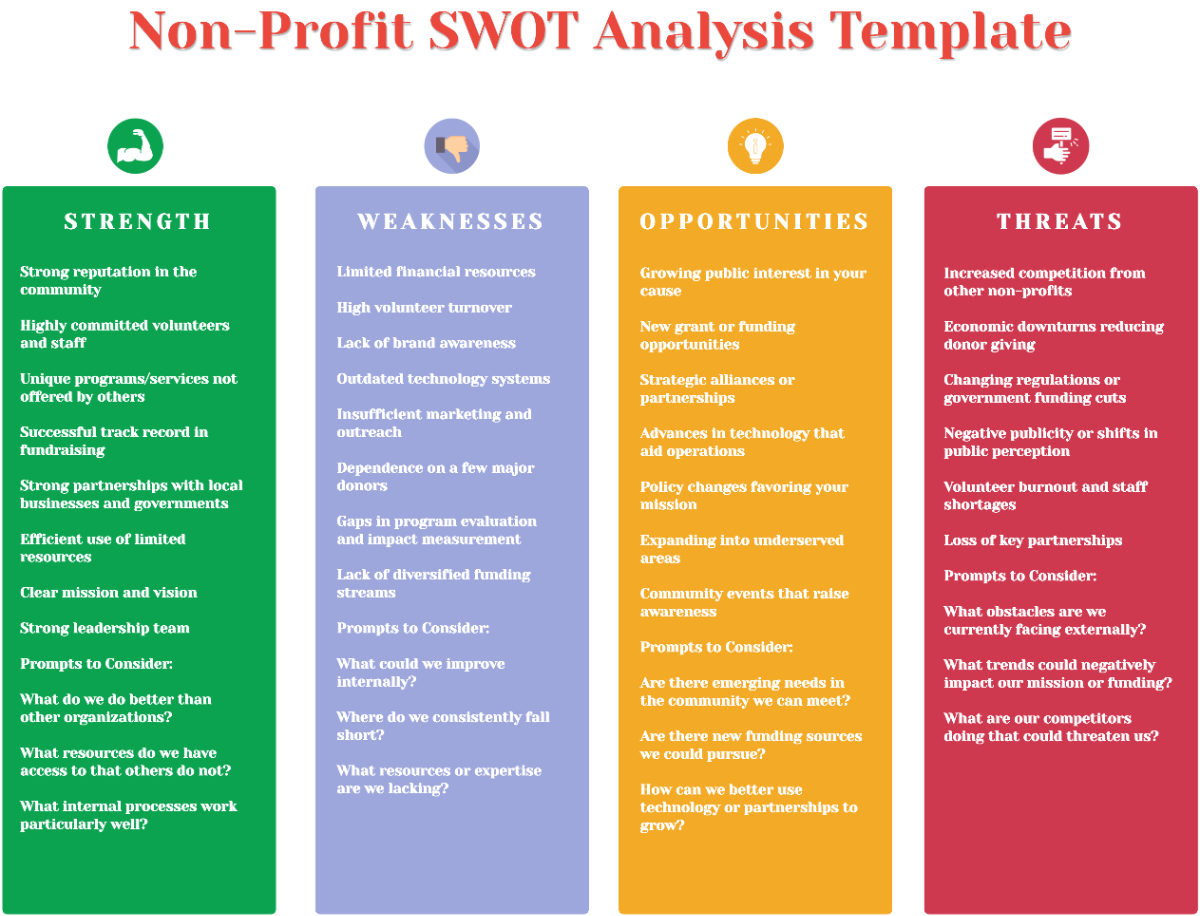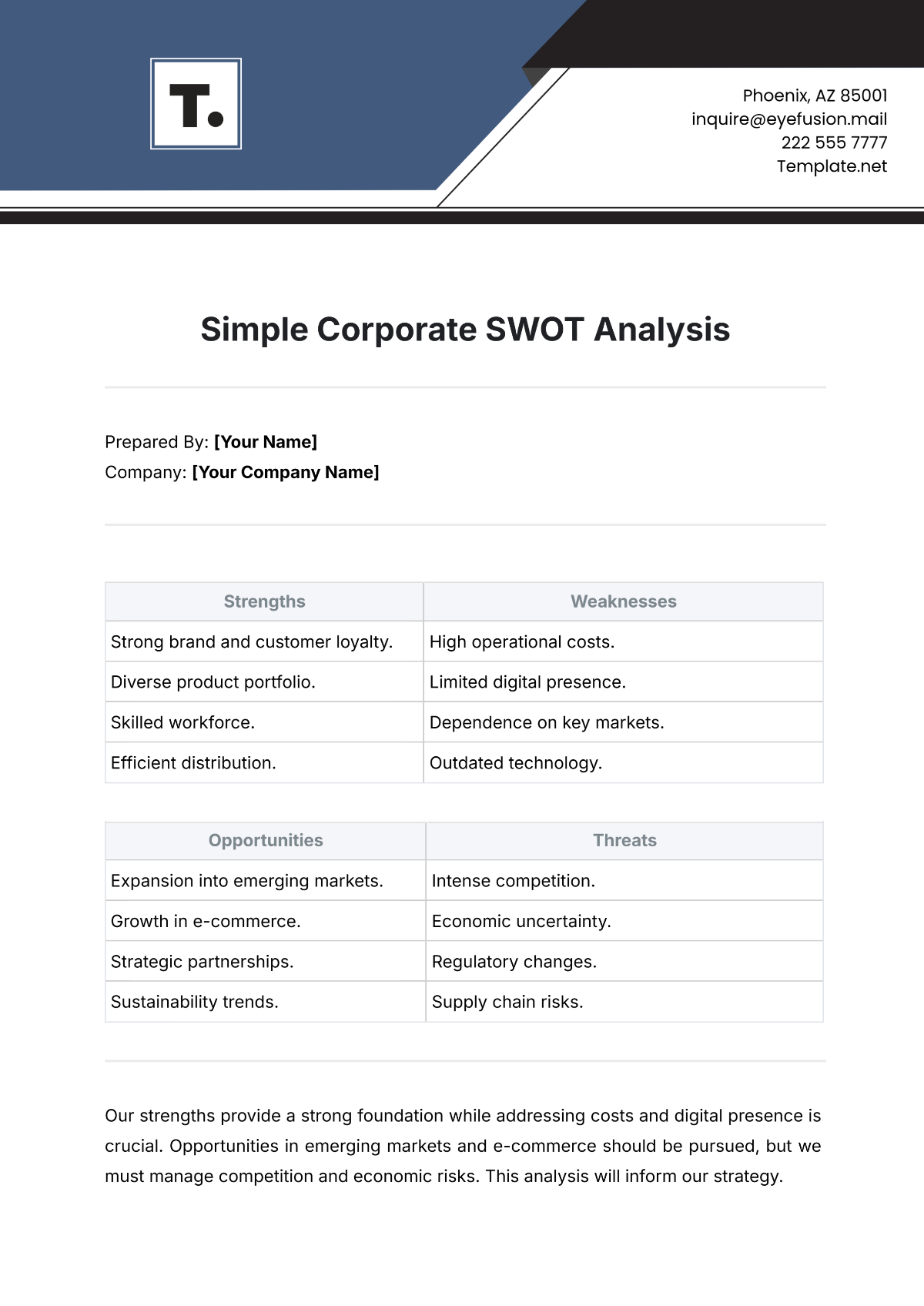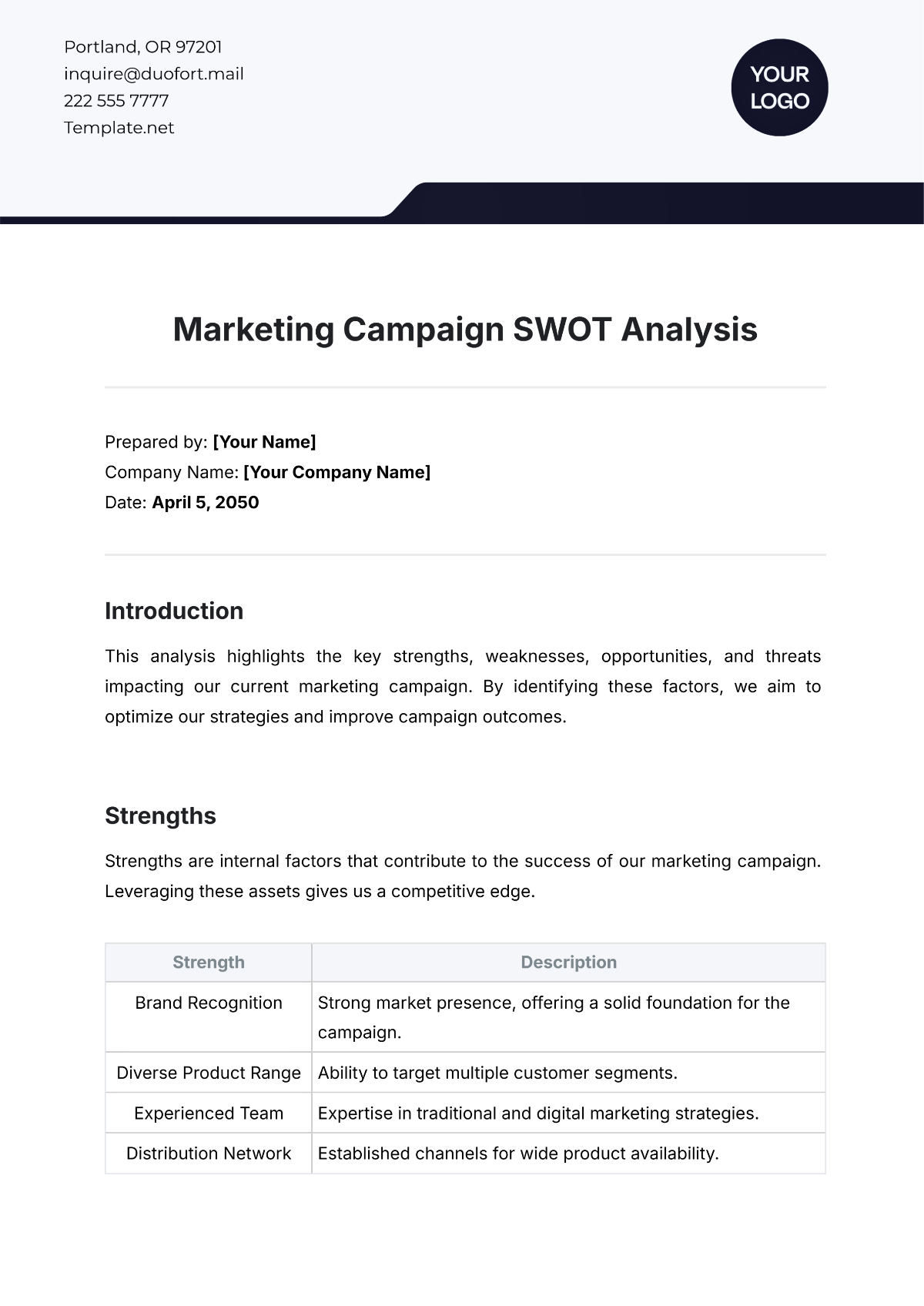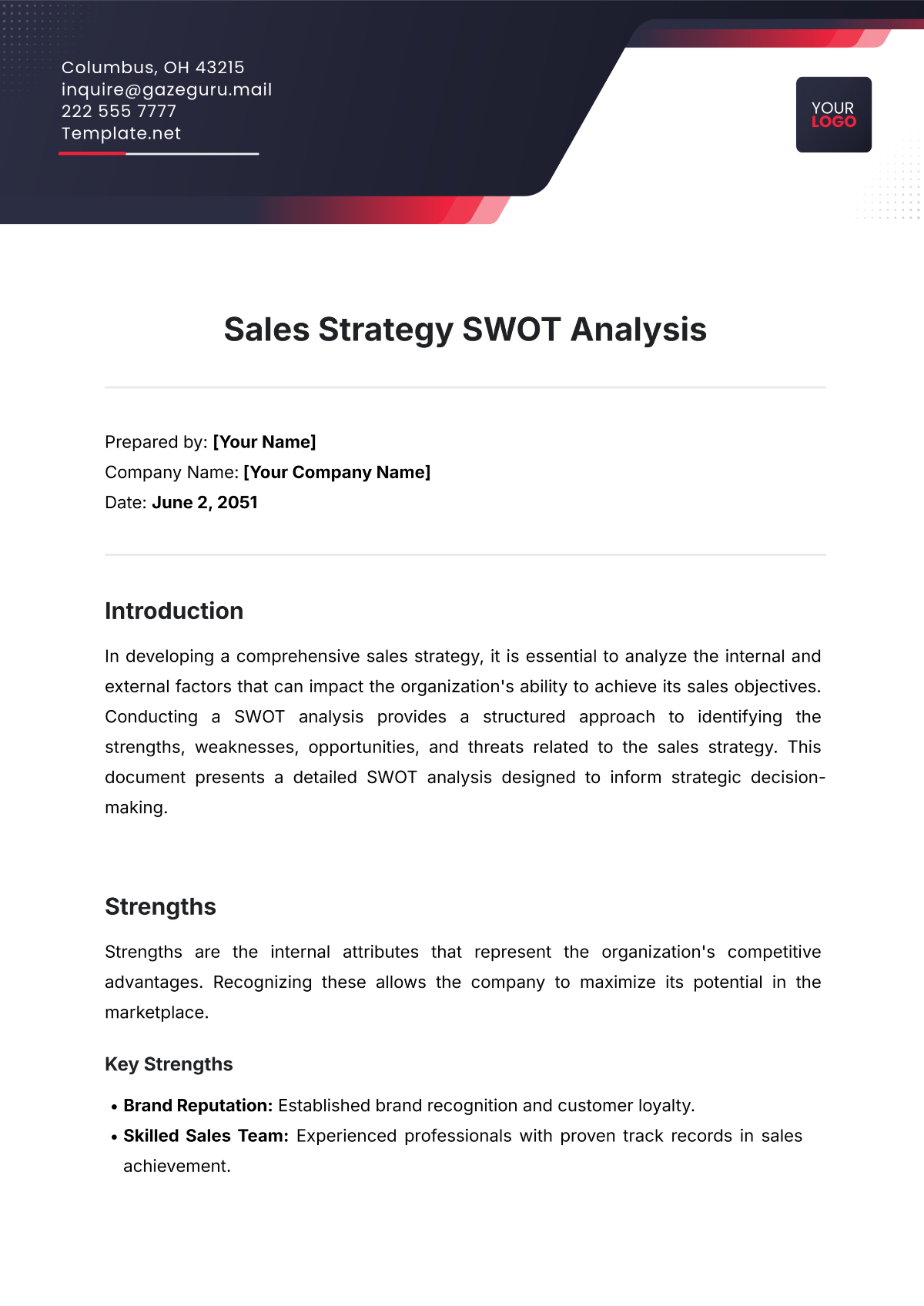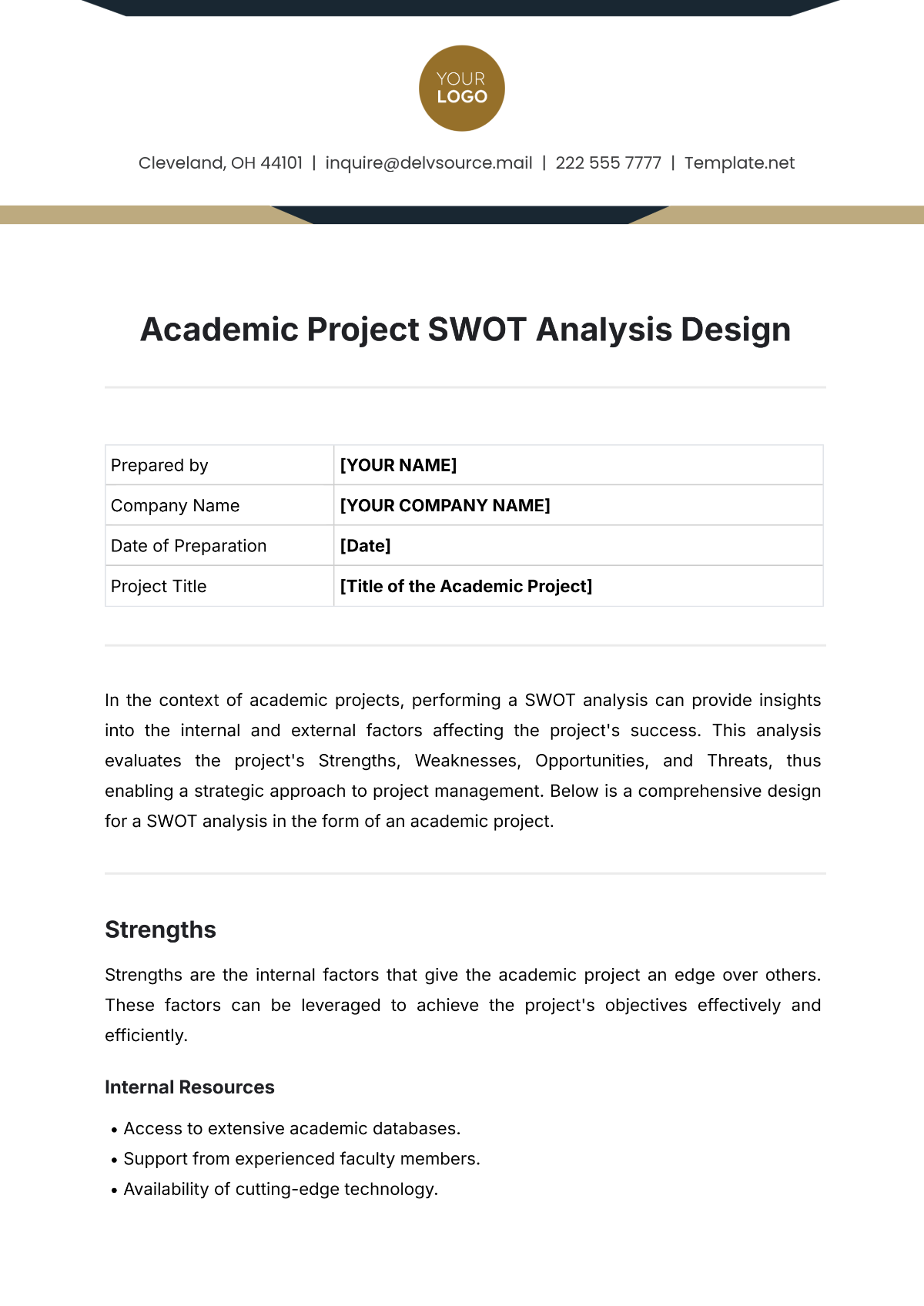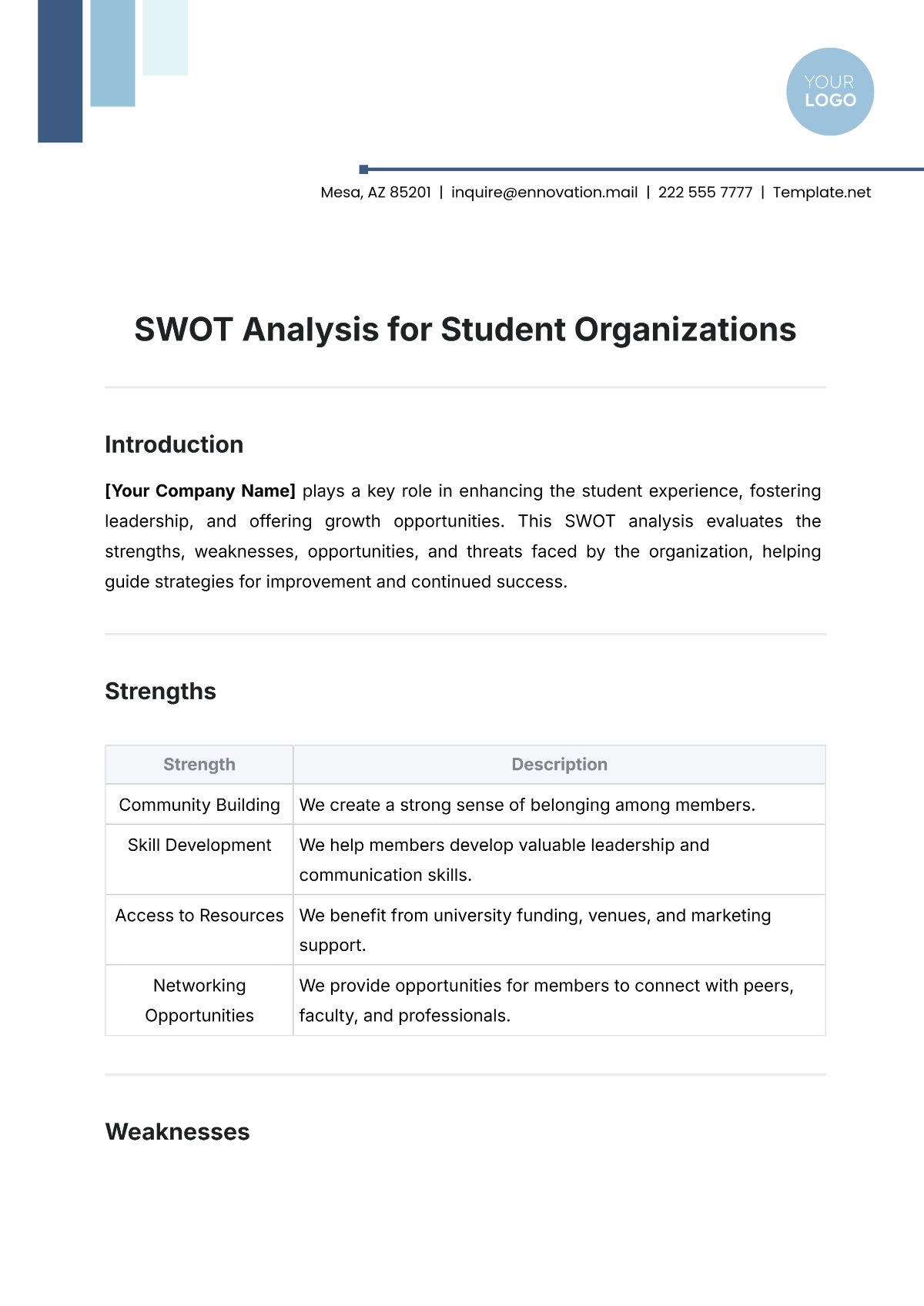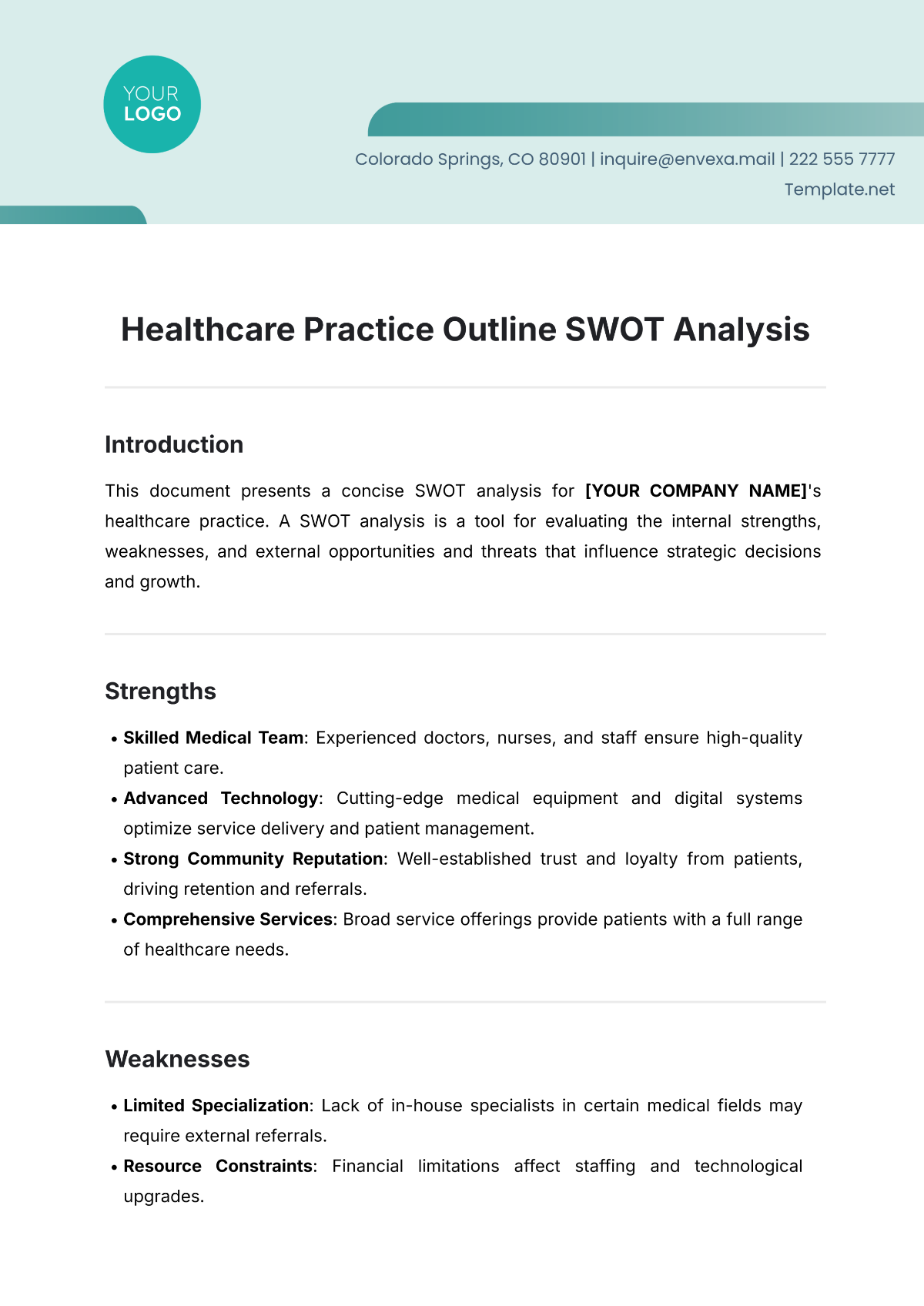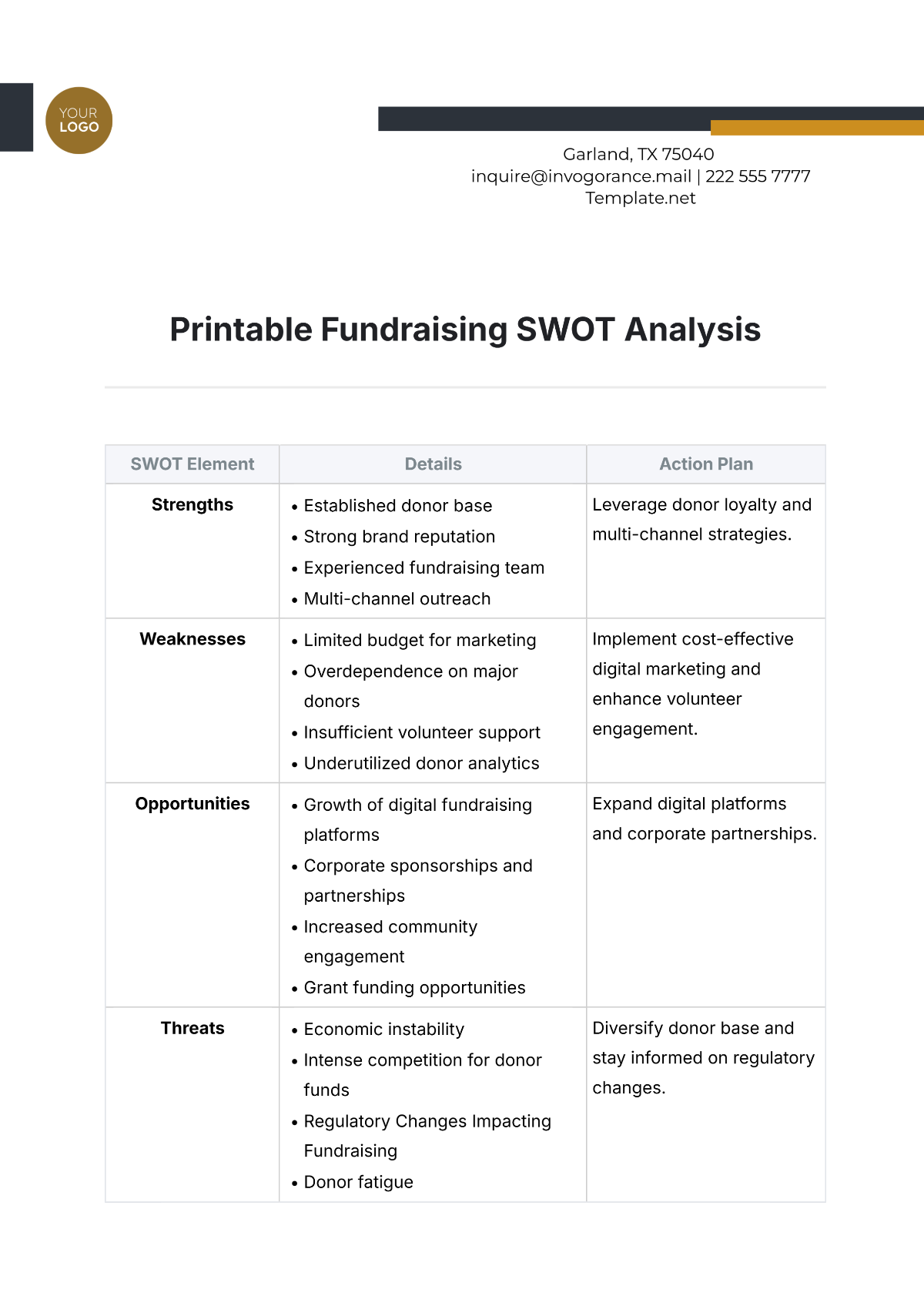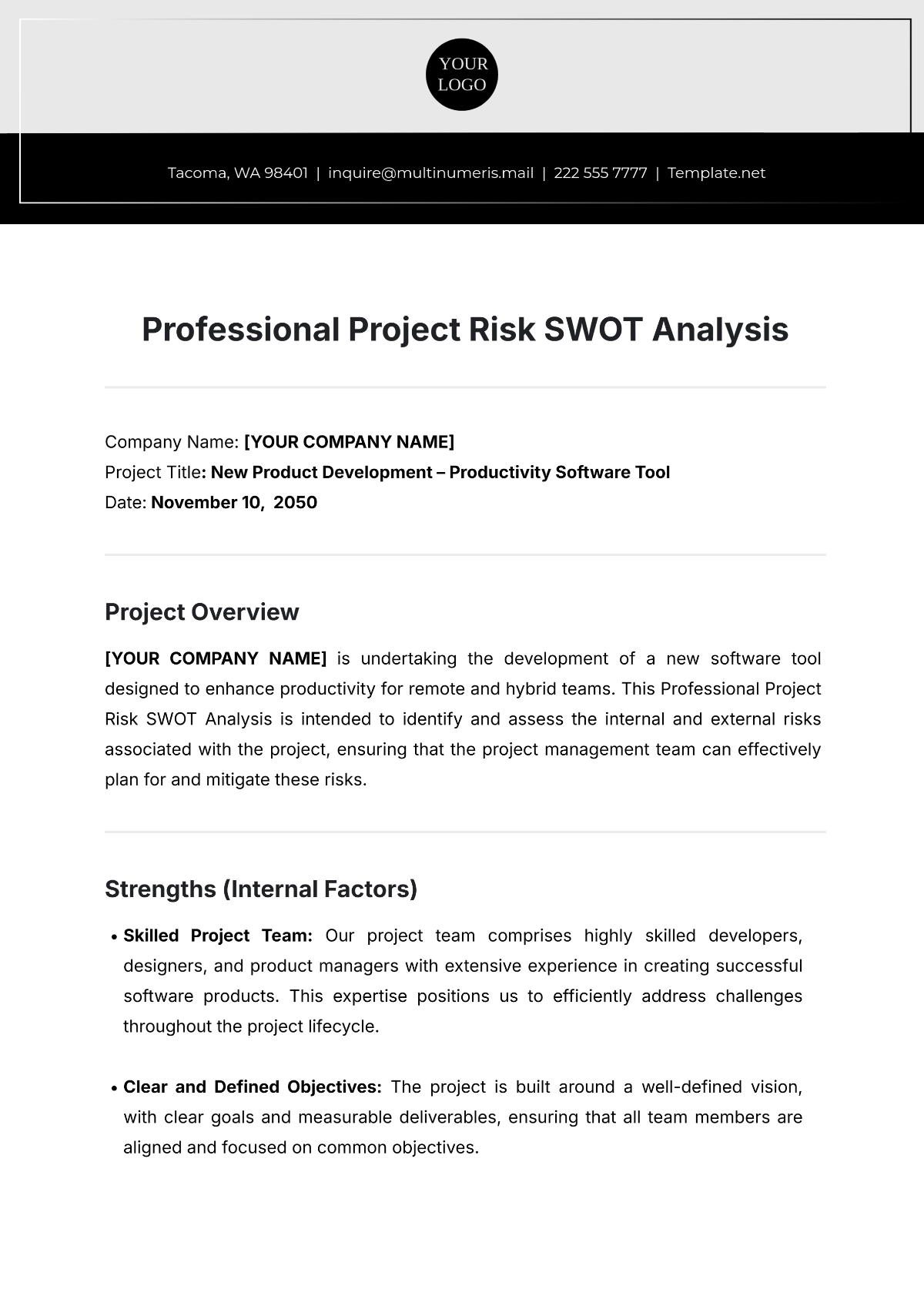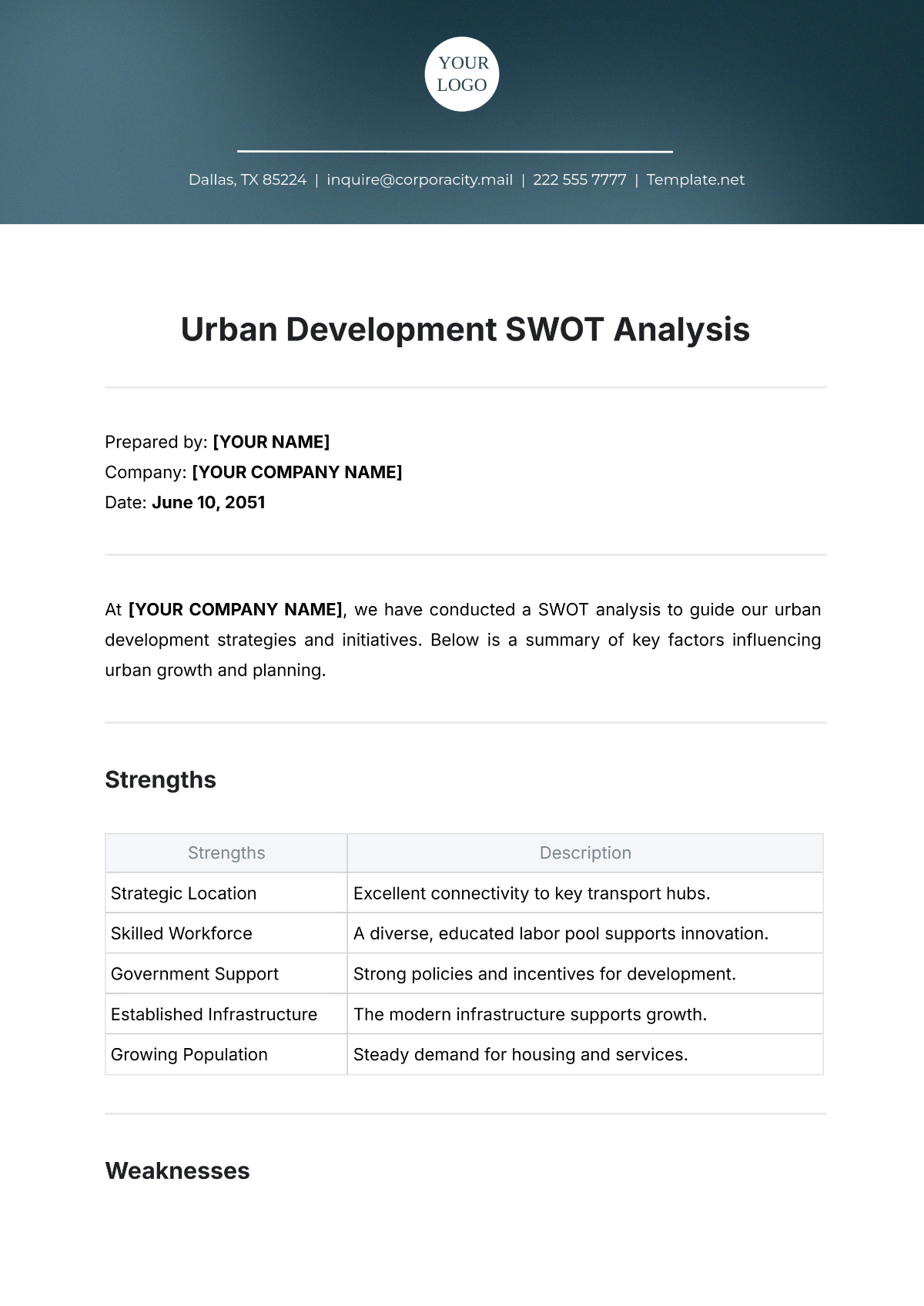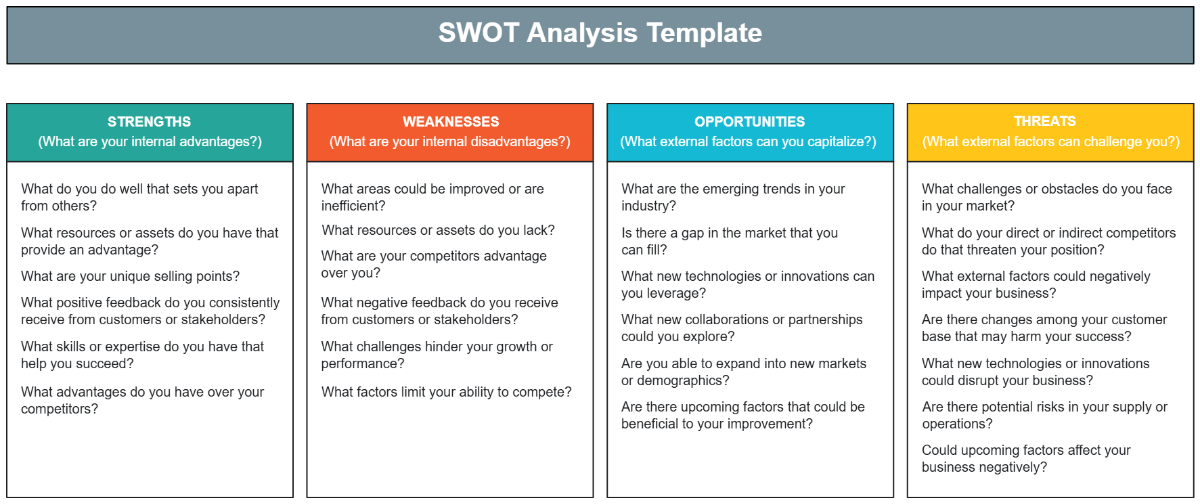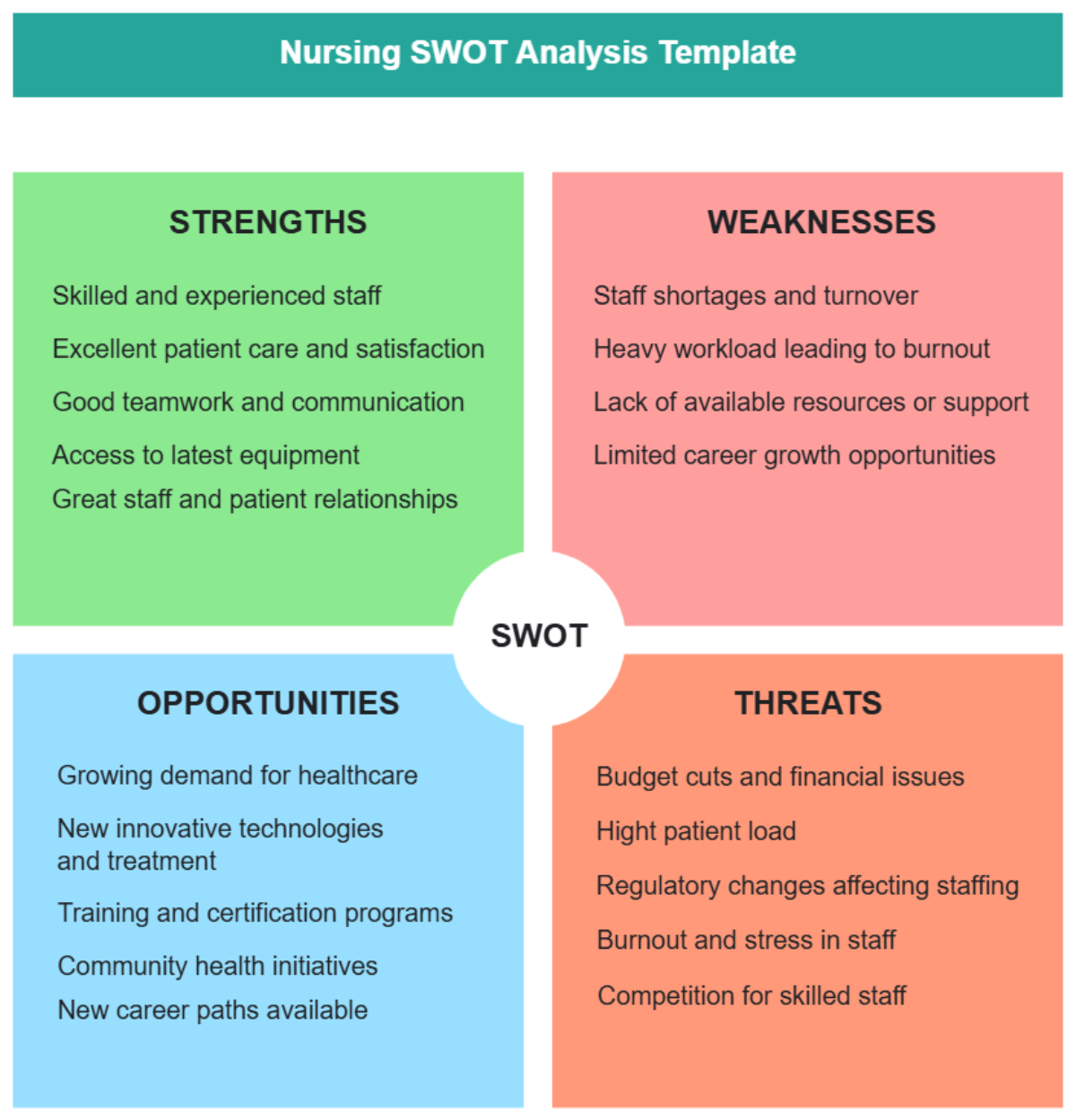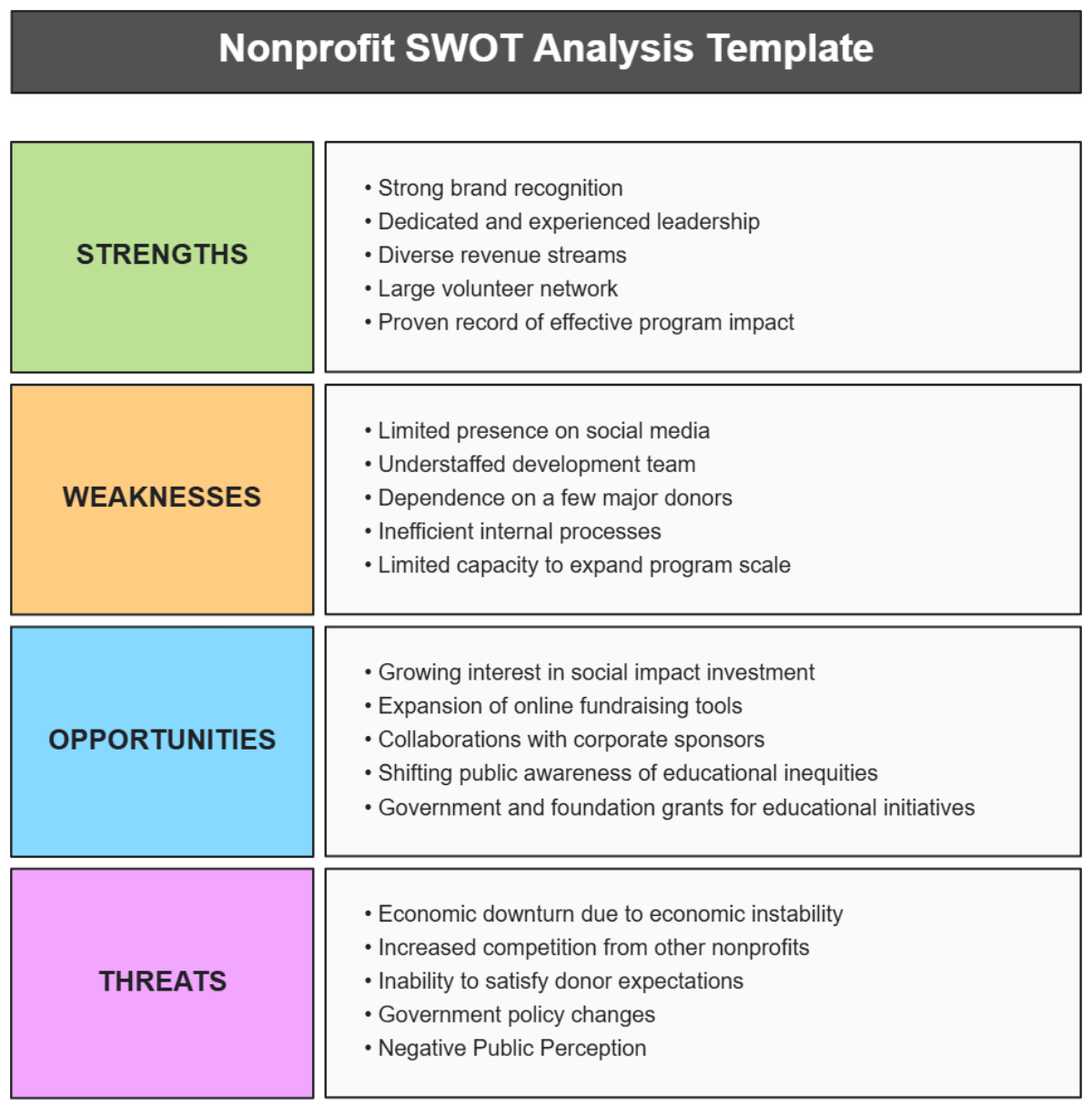Marketing SWOT Analysis
Date Created: January 1, 2050 Document Version: 1.0
Executive Summary
[Your Company Name] operates in a dynamic business environment that demands a forward-thinking and adaptive approach to remain competitive and sustainable. This SWOT analysis delves into key aspects of the company's current position, both internally and externally, to guide future strategies and actions.
Purpose
The purpose of conducting this comprehensive SWOT analysis for [Your Company Name] is multifaceted, with a primary focus on guiding the organization's strategic decisions and actions as it navigates the business landscape well into the future. This analysis serves several crucial functions:
Strategic Planning: The SWOT analysis forms the cornerstone of [Your Company Name]'s long-term strategic planning. By systematically evaluating internal strengths and weaknesses and external opportunities and threats, the company can develop a clear roadmap for achieving sustainable growth and success.
Informed Decision-Making: In an era of rapid technological advancements and evolving market dynamics, making informed decisions is paramount. The SWOT analysis equips [Your Company Name]'s leadership and decision-makers with valuable insights to make strategic choices aligned with the company's vision and goals.
Risk Mitigation: Identifying potential threats and weaknesses early on allows [Your Company Name] to proactively devise risk mitigation strategies. This proactive approach minimizes vulnerabilities and enhances the organization's ability to withstand unforeseen challenges.
Capitalizing on Opportunities: Recognizing and harnessing external opportunities is essential for continued growth and market relevance. The analysis highlights potential avenues for expansion and diversification that the company can leverage to gain a competitive edge.
Resource Allocation: [Your Company Name] can use the SWOT analysis to allocate resources more efficiently. By understanding where its strengths lie and where improvements are needed, the company can optimize its
investments and prioritize critical areas.
Enhancing Competitiveness: In a fiercely competitive landscape, staying ahead requires constant evaluation and adaptation. The SWOT analysis aids the company in identifying areas where it can differentiate itself from competitors and maintain a leadership position.
Long-Term Vision: Beyond immediate concerns, this analysis assists in shaping a clear and compelling long-term vision for [Your Company Name]. It outlines strategic objectives, milestones, and a forward-looking perspective that extends well into the second half of the century.
Stakeholder Communication: The insights gathered from the SWOT analysis can be effectively communicated to stakeholders, including investors, employees, and customers. Demonstrating a commitment to addressing challenges and seizing opportunities enhances stakeholder confidence.
SWOT Analysis Table
STRENGTHS | WEAKNESSES |
|
|
OPPORTUNITIES | THREATS |
|
|
Strengths
Strong Brand Reputation: [Your Company Name] has cultivated an impeccable brand reputation through decades of delivering high-quality products and exceptional customer service. Customers associate the brand with reliability and trustworthiness, which has led to a loyal customer base. For example, when consumers think of luxury automobiles, they immediately think of the company’s reputation for craftsmanship and performance.
Innovative Product/Service: The company's commitment to innovation is exemplified by its track record of introducing groundbreaking products/services. [Your Company Name] has consistently pushed the boundaries of technology and design. An illustrative example is [Your Company Name]'s pioneering electric vehicle lineup, which set new industry standards and revolutionized the automotive market.
Skilled Workforce: [Your Company Name] prides itself on a highly skilled and motivated workforce. The company invests in continuous employee training and development, fostering a culture of expertise and dedication. This dedication is evident in the precision and attention to detail seen in the company’s manufacturing processes, as demonstrated by the consistent quality of its products.
Global Presence: [Your Company Name] operates globally, with a network of subsidiaries and distribution channels in numerous countries. This expansive reach not only provides access to diverse markets but also allows the company to adapt its products and marketing strategies to local preferences and regulations. For instance, the company tailors its menu offerings in different regions to cater to local tastes and dietary restrictions.
Financial Stability: The company boasts a robust financial foundation, with a healthy balance sheet and a history of profitability. This financial stability enables [Your Company Name] to weather economic downturns and invest in long-term projects. An example is the company's ability to fund research and development initiatives that have resulted in breakthrough products, such as advanced medical devices that have transformed patient care.
Weaknesses
Dependence on Key Suppliers: [Your Company Name] relies heavily on a select group of suppliers for critical components. This dependence poses a risk in the event of supplier disruptions or price fluctuations. For instance, the company's smartphone manufacturing heavily relies on a single supplier for microchips, making the supply chain vulnerable to shortages.
Limited Product/Service Range: While the company excels in its core offerings, its product/service portfolio may lack diversification. This limitation could hinder the company's ability to capture a broader market share. An example is the company's focus primarily on high-end luxury cars, leaving untapped potential in the mid-range automobile market.
High Operating Costs: [Your Company Name] faces significant operational expenses, including labor, raw materials, and energy costs. These high costs affect profit margins and may necessitate higher prices for customers. As an illustration, [Your Company Name]'s airline division faces ongoing challenges with fuel costs, which can result in higher ticket prices compared to competitors.
Limited Digital Presence: [Your Company Name] has been slow to embrace digital marketing and e-commerce compared to industry peers. This lag in online engagement hinders its ability to reach tech-savvy consumers and capitalize on the growing digital market. For example, the company has yet to leverage influencer marketing effectively, missing out on a popular advertising channel among younger demographics.
Environmental Impact: The company's operations have a notable environmental footprint, particularly in terms of carbon emissions and resource consumption. As environmental consciousness grows, this weakness could lead to reputational damage and consumer backlash. An example is the energy-intensive manufacturing processes, which are not aligned with sustainability goals and may deter eco-conscious consumers from its products.
Opportunities
Emerging Markets: [Your Company Name] can explore untapped emerging markets, such as regions in Africa and Southeast Asia, where rapid economic growth is creating new consumer segments with disposable income. For example, entering the African market could open up opportunities in the mobile technology sector, as smartphone adoption rates are on the rise.
Technological Advancements: Leveraging advancements in technology, [Your Company Name] can introduce smart, connected products/services. For instance, in the healthcare sector, the company can develop wearable medical devices that monitor patient health in real-time and transmit data to healthcare providers for remote monitoring.
Sustainability Focus: With increasing consumer awareness of environmental issues, [Your Company Name] can develop eco-friendly products or transition to sustainable manufacturing processes. An example is a car manufacturer shifting to electric vehicles and sustainable materials to meet the growing demand for green transportation solutions.
E-commerce Expansion: Investing in an online presence and e-commerce platforms can help [Your Company Name] reach a broader customer base. For instance, a traditional brick-and-mortar retailer can create a user-friendly e-commerce website and mobile app to tap into the booming online shopping trend.
Strategic Partnerships: Collaborating with complementary businesses can create synergies and open new distribution channels. For example, a food delivery service can partner with local restaurants to expand its menu options and geographic reach, benefiting both parties.
Threats
Intense Competition: The industry is highly competitive, with new entrants and established players vying for market share. Example: In the tech industry, the constant influx of startups with innovative solutions can pose a threat to [Your Company Name]'s market dominance.
Regulatory Changes: Evolving regulations and compliance requirements could pose challenges and increase operational costs. Example: In the financial sector, stricter data protection regulations may require substantial investments in cybersecurity to remain compliant.
Economic Downturn: Economic recessions or financial crises may reduce consumer spending and affect [Your Company Name]'s revenue. Example: In the luxury goods market, during economic downturns, consumers tend to cut back on discretionary spending, impacting luxury retailers' sales.
Cybersecurity Risks: Increasing cyber threats could jeopardize customer data and company operations. Example: A data breach that exposes sensitive customer information can lead to reputational damage and legal consequences.
Supply Chain Disruptions: Natural disasters, geopolitical tensions, or other unforeseen events may disrupt the supply chain and impact production. Example: A semiconductor shortage, as witnessed in the automotive industry, can lead to production delays and reduced product availability.
SWOT Action Plan
Leveraging Strengths:
Enhance Brand Reputation: To capitalize on our strong brand reputation, [Your Company Name] will invest in brand-building activities, including sponsorships, partnerships, and community engagement initiatives. These efforts will reinforce trust and loyalty among our customers.
R&D Investment: Allocate a higher budget to research and development to maintain our position as an industry innovator. This investment will lead to the development of new and advanced products/services that align with market trends.
Employee Training and Development: Continue to nurture our skilled workforce by providing ongoing training and development opportunities. Encourage a culture of innovation and creativity to ensure our team remains motivated and committed.
Global Expansion Strategy: Strategically expand into emerging markets while optimizing our presence in existing ones. Tailor our products/services to meet local demands and preferences to further diversify our customer base.
Financial Prudence: Maintain a keen focus on financial stability. Regularly review and optimize our financial strategies, including cost management and revenue diversification, to ensure long-term sustainability.
Addressing Weaknesses:
Supplier Diversification: Identify alternative suppliers and establish backup plans to reduce dependence on key suppliers. This will enhance the resilience of our supply chain against disruptions.
Product/Service Portfolio Enhancement: Conduct market research and customer surveys to identify gaps in our product/service range. Invest in new product/service development and improvements to better meet evolving customer needs.
Cost Optimization Initiatives: Implement cost-cutting measures through process optimization, resource allocation, and procurement strategies to reduce operating costs and improve profit margins.
Digital Transformation: Develop a comprehensive digital marketing and e-commerce strategy to boost our online presence. This will enable us to tap into the growing digital market and provide a seamless online shopping experience for our customers.
Sustainability Initiatives: Launch sustainability programs to reduce our environmental impact. This may include adopting eco-friendly production practices, reducing waste, and offering green product options to cater to eco-conscious consumers.
Seizing Opportunities:
Market Entry Plan for Emerging Markets: Develop a well-researched market entry strategy for emerging markets, considering factors such as local regulations, cultural nuances, and competition dynamics. This will ensure a successful expansion into new territories.
Technology Integration: Embrace emerging technologies such as AI, IoT, and blockchain to enhance operational efficiency, improve customer experiences, and create innovative solutions for our industry.
Sustainability Certification: Pursue sustainability certifications and initiatives that demonstrate our commitment to eco-friendliness. This can be a powerful marketing tool to attract environmentally conscious consumers.
E-commerce Platform Development: Launch a user-friendly e-commerce platform and digital marketing campaigns to expand our online customer base and provide a seamless online shopping experience.
Strategic Alliances: Identify potential strategic partners and explore collaboration opportunities to access new markets, distribution channels, or complementary technologies.
Mitigating Threats:
Competitive Analysis and Response: Continuously monitor competitors and adapt our strategies to stay competitive. Regularly review and update our products/services to meet changing customer preferences.
Regulatory Compliance: Stay proactive in understanding and complying with evolving regulations. Invest in legal counsel and regulatory experts to ensure we meet all compliance requirements.
Diversification of Revenue Streams: Explore diversification options, such as offering new product lines or expanding into related industries, to reduce our vulnerability to economic downturns.
Cybersecurity Protocols: Strengthen cybersecurity measures, including regular audits, employee training, and technology updates, to safeguard customer data and business operations.
Supply Chain Resilience: Develop a comprehensive supply chain risk management strategy, including contingency plans, alternative suppliers, and stockpiling essential components to mitigate supply chain disruptions.
Risk Management
Intense Competition:
Develop a competitive intelligence system to continuously monitor competitors' strategies and respond proactively.
Invest in intellectual property protection to safeguard unique product innovations.
Regulatory Changes:
Establish a dedicated compliance team to stay updated on changing regulations and ensure full compliance across all operations.
Maintain open communication channels with industry associations and regulatory bodies to influence favorable regulatory changes.
Economic Downturn:
Create a financial resilience plan, including cash flow forecasting and expense reduction strategies, to weather economic downturns.
Diversify revenue streams by exploring new markets or complementary business lines that are less vulnerable to economic fluctuations.
Cybersecurity Risks:
Implement robust cybersecurity measures, including regular security audits and employee training, to protect customer data and operational integrity.
Invest in cyber insurance to mitigate potential financial losses in case of a cyberattack.
Supply Chain Disruptions:
Develop a supply chain risk assessment system to identify vulnerabilities and implement contingency plans.
Consider dual-sourcing strategies and explore options for local or regional suppliers to reduce dependency on a single source.
Conclusion
The SWOT analysis for [Your Company Name] provides a comprehensive overview of the company's current position and prospects. Leveraging its strengths, the company is well-poised to seize emerging opportunities and overcome weaknesses while proactively mitigating potential threats.
By aligning its long-term vision with strategic objectives, such as innovation, sustainability, digital transformation, global expansion, and customer-centricity, [Your Company Name] aims to not only survive but thrive well in the future. These strategic initiatives will ensure the company's continued growth, profitability, and its ability to adapt to the evolving business landscape.
As the company moves forward, a dedicated focus on executing the action plan derived from this SWOT analysis will be instrumental in realizing its long-term vision and maintaining a leadership position in the industry. Through diligent risk management and a commitment to excellence, [Your Company Name] is poised for success.
